| |||||||
| Search Forums |
| Advanced Search |
| Go to Page... |
 |
| Search this Thread |  876,340 views |
| | #1 |
| Team-BHP Support  | Maruti Swift : Official Review The Maruti Swift is on sale in India at a price of between Rs. 4.99 - 8.29 lakhs (ex-Delhi). What you'll like: • The same successful formula (including good looks)...now improved • Stylish black cabin, with better rear seat space & boot capacity than the outgoing car • Sweet petrol & an efficient diesel. AMT available with both engines for just 47k extra • Fun to drive, especially the slick Petrol MT. Enjoyable handling & on-road behaviour • Impressively equipped (Auto LED headlamps + DRLs, reversing camera, Apple & Android touchscreen ICE…) • Dual airbags, ABS & ISOFIX child seat mounts are standard across the range • Maruti's widespread service network, excellent after-sales support & fuss-free ownership experiences What you won't: • The more spacious & comfortable Baleno is priced not too far away. Likewise with the i20 • Old 1.3L DDiS motor is nowhere as competent as the i20, Figo & Polo diesels • Mediocre plastic quality (interiors) is typical Maruti grade; very ordinary • Diesel AT is too jerky. AMT, although improved, can’t match conventional ATs on smoothness & speed • 163 mm of ground clearance & small 37-liter fuel tank raise our eyebrows • Some misses (auto-dimming IRVM, skinny 165 mm tyres on L & V variants, rear air-con, smaller spare tyre on the Z trims...) • Waiting periods have already begun Last edited by GTO : 19th April 2018 at 11:42. |
| |  (62)
Thanks (62)
Thanks
 |
| The following 62 BHPians Thank Aditya for this useful post: | AltoLXI, am1m, anshuman1117, artemis_fowl, Ashir, Avikbrio, BlackPearl, Brumby, CarguyNish, carrazy, chiranjitp, dailydriver, darklord, dkaile, espraveen, Flyer, Gannu_1, Grand Drive, GTO, gunsho, InControl, kozhissery, lemedico, Leoshashi, libranof1987, mi2n, N33raj, Nimalan, Nohonking, Nonstop-driver, Obi-Wan, Omkar, PowerSpike, PrasunBannerjee, R-Six, Rambo-RS, Researcher, romeomidhun, RoverX, rshanker, S.MJet, samabhi, sdp1975, Sheel, Simhi, Singh09, Sip, SJM1214, SnS_12, Sudeep_Kimster, suhaas307, sunny29584, swiftdiesel, swiftnfurious, theexperthand, uday.ere, vaasu, Varun_HexaGuy, vb-saan, VeluM, Vik0728, VTec_KickedInYo |
| |
| | #2 |
| Team-BHP Support  | Review Index: Exterior Last edited by GTO : 19th April 2018 at 12:11. |
| |  (21)
Thanks (21)
Thanks
 |
| The following 21 BHPians Thank Aditya for this useful post: | AltoLXI, carrazy, espraveen, Gannu_1, GTO, Leoshashi, Nimalan, Obi-Wan, oil_burner, Rambo-RS, Researcher, romeomidhun, RoverX, sandx, Sheel, suhaas307, theexperthand, uday.ere, vb-saan, VeluM, Vik0728 |
| | #3 |
| Team-BHP Support  | Exterior 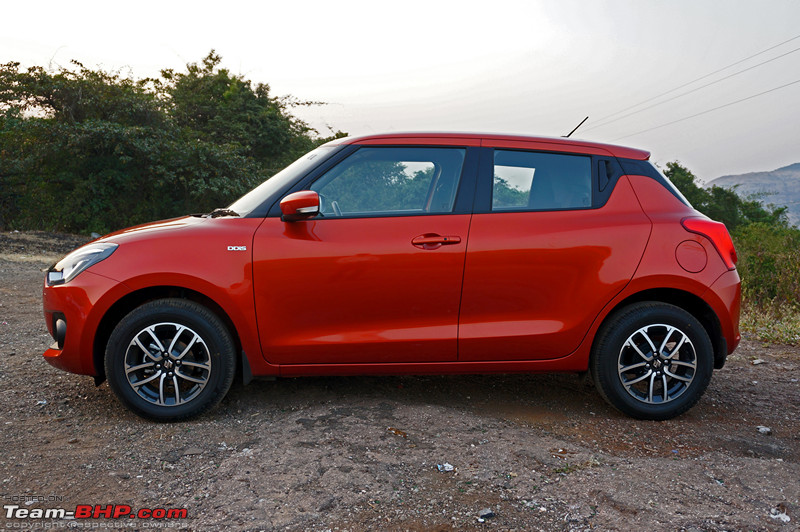 In India, the B2 segment makes for the largest share of the pie in terms of sales. It's also more profitable than the A segment which was historically the biggest. For a product to succeed in the B2 segment, it has to be modern, well-equipped, stylish and backed by a strong service network. Customer demands are continually increasing in terms of engine competence levels, gizmos, automatics, overall quality & more. No wonder then that even global giants such as Toyota & Ford have not managed to get the formula right so far. Maruti and Hyundai have found the pulse of the buyers with multiple models on offer. Hatchbacks like the Swift, Baleno, Grand i10 and Elite i20 sit right at the top, clearly giving customers exactly what they want. Maruti has another model in the segment - the Ignis. However, it has not been as successful as its other offerings in the segment, although considering its premium pricing, the Ignis is doing well. The Swift has been a game-changing product from the time of its original launch. It is also one of the company's best-selling models making it a very important car in the product portfolio. It has always sold in good numbers over the years, with monthly sales regularly crossing the 15,000 unit mark. While the Swift was leading the B2 segment for the longest time, in recent months, it has been feeling the heat from the two Hyundais and its own sibling - the Baleno. The Baleno is mechanically identical to the Swift, but offers more practicality with better cabin and boot space. There's no doubt that the Swift was showing its age. Considering the Swift's successful run, it is no wonder that Maruti has opted for an "evolutionary" approach with this next-gen model. What is good to know is that the new car is priced just slightly higher than the outgoing model, considering the additional safety features that are available as standard. Among the engines, Maruti is charging a little over Rs. 1 lakh more for the diesel engine over the petrol mill. Another important point to note is that the Swift comes with an AMT automatic on both engines this time around (~47k premium over the MT). The AMT is available on the middle V and Z trim levels. This means it loses out on useful features like the touchscreen infotainment and reversing camera. Someone looking at the AMT will have to settle for lesser features, which is sad as an Z+ AMT would be a perfect option for someone looking at a city hatch with a premium feel. That said, the AMT gearbox, which is cheaper than conventional automatic transmissions, should have ideally made the Swift substantially cheaper than its rivals, but surprisingly, it hasn't!! The car is priced similarly to its rivals. In fact, in some cases, you can get cars with more accomplished automatic gearboxes at similar or slightly higher prices. Still, it is evident that the target market has found the car's pricing to be acceptable, going by the 100,000+ bookings up already. As one would expect, there is a waiting period for the car at present. At 3,840 mm, the new Swift is 10 mm shorter in length than its predecessor. However, at 1,735 mm, it is 40 mm wider than the old car. In fact, save for the Baleno, it is the widest hatchback in the B2 segment. Measuring 1,530 mm in height, it is just as high as the outgoing car. Its wheelbase of 2,450 mm is 20 mm longer, but at 163 mm, the ground clearance has been reduced by 7 mm compared to the old car. Not at all cool in India where we have mountains masquerading as speed breakers. It is also the lowest among all its rivals. We must remember this is the unladen ground clearance of the car. 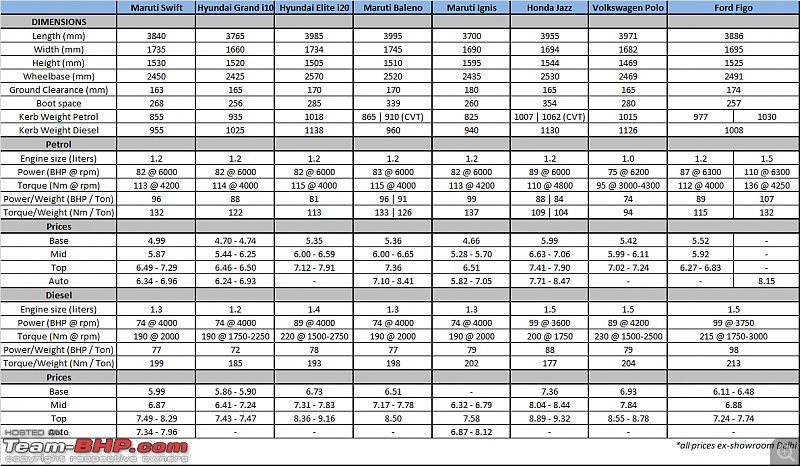 The previous two generations of the Swift looked remarkably similar to each other. The new car changes that. The front and rear ends of the car are completely different compared to the outgoing car. Opinions about its looks among BHPians and in the Team-BHP office remain divided. While we find the new Swift to be contemporary-looking, some feel that the character of the old car is missing. At the front, there is a large, hexagonal grille with black horizontal slats and a prominent chrome 'S' badge in the center. Like the old car, the new Swift gets sweptback headlamps, but they are more angular than before. The headlamp cluster houses U-shaped LED DRLs and LED headlights housed in projectors. Sadly, these are available only on the top end Z+ trim and the lower variants have to make do with regular halogen bulbs housed in boring reflectors (no LED DRLs either). There is a new clamshell bonnet and round foglamps with black housings. The front is more mature-looking than before and except for the badge, there is no application of chrome at the front - just the way we like it. Viewed from the side, the car looks very proportionate. The design is clean without any cuts and creases. There is no use of chrome either. Maruti has also equipped the car with smart-looking precision cut 15-inch alloy wheels. At the rear, there is a pair of LED tail-lamp clusters (indicator & reversing lights are regular halogen) with a couple of chrome badges on the boot lid. Once again, the use of chrome is kept to a bare minimum. The fit & finish are good with uniform panel gaps all over. The Swift is based on the HEARTECT platform, which underpins the Baleno as well as the Dzire. With this lightweight platform, it weighs just 855 - 985 kg depending upon the variant. For the record, the older car weighed 965 - 1060 kg. That is quite a reduction! As expected, the low weight is reflected in the build of the car. The doors, bonnet and boot are very light, but there is just a bit of flex when the sheet metal is pressed with your thumb. Overall build quality is satisfactory - it’s not Euro solid, yet it feels better than Maruti’s usually light + flimsy builds. Maruti claims that it has used 40% high tensile steel to improve the Swift's strength and rigidity. The car is available in 6 paint shades and the paint job is good. Coming to safety, the Swift gets two airbags, ABS + EBD with brake assist, ISOFIX child seat mounts and seatbelt pretensioners with load limiters as standard. We are pleased with this decision as the non-ABS variants of the last-gen Swift suffered from poor braking ability. While the India-spec car has not been crash tested by NCAP or other independent bodies, Maruti claims that it is compliant for upcoming Indian pedestrian safety, side-impact and offset crash regulations ahead of the set timeline. That said, it must be noted that the Euro-spec Swift, which is equipped with six airbags, managed to score a not-so-impressive 3 stars in crash tests conducted by the Euro NCAP. That is disappointing for a brand new model. With the addition of an autonomous radar brake support system, the car was awarded a 4-star rating. The chic fascia is dominated by a large, black grille that is flanked on both sides by LED projector headlamps with daytime running lights (DRLs). BHPians have commented that it could have been influenced by various other cars including the Jaguar F-Type: 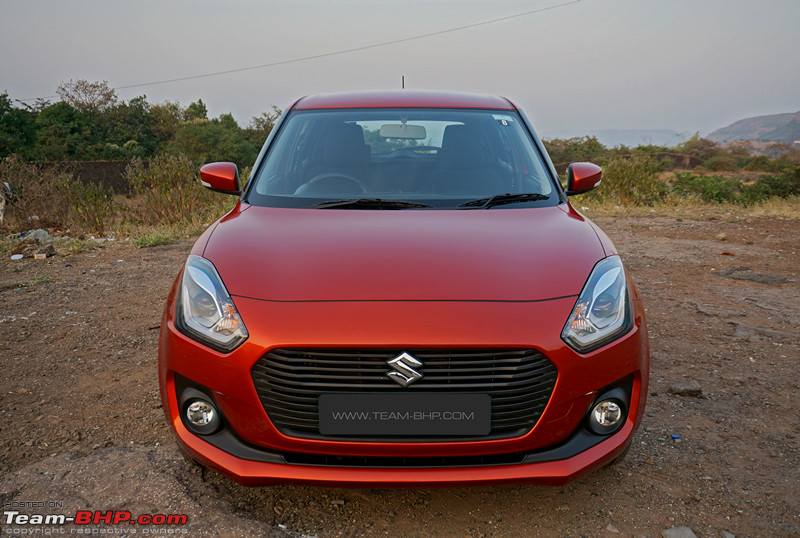 Rear end is sedate + simpler compared to the front. With the tail-lamps sweeping forward and the hatch sticking out slightly, comparisons have been drawn to the Datsun GO. Apart from the badges, there is no chrome used, which is just the way we like it. Windscreen looks small for all that sheet metal below it. What's missing is the stylishly-placed center foglamp of the old Swifts (reference image): 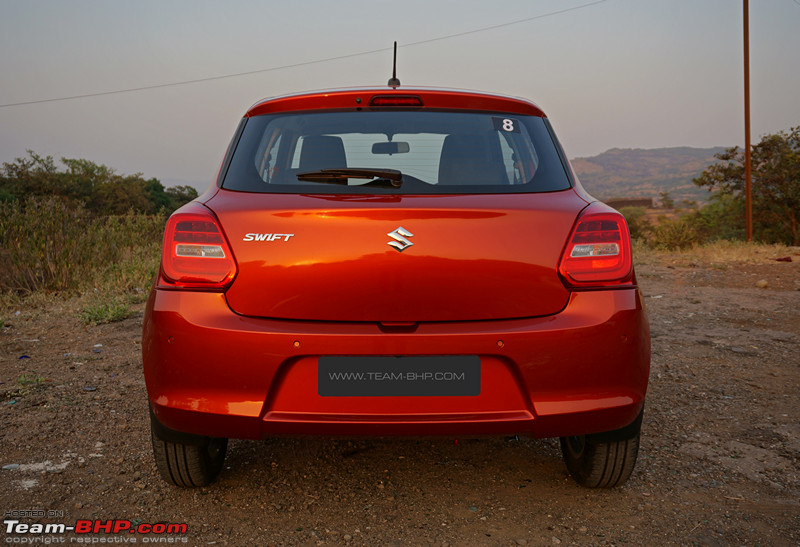 The new Swift is 10 mm shorter in length compared to the older car. However, its width has been increased by 40 mm and at 2,450 mm, the wheelbase has been upped by 20 mm. On the other hand, the ground clearance at 163 mm is 7 mm less than its predecessor! The height (1,530 mm) is the same as the outgoing car: 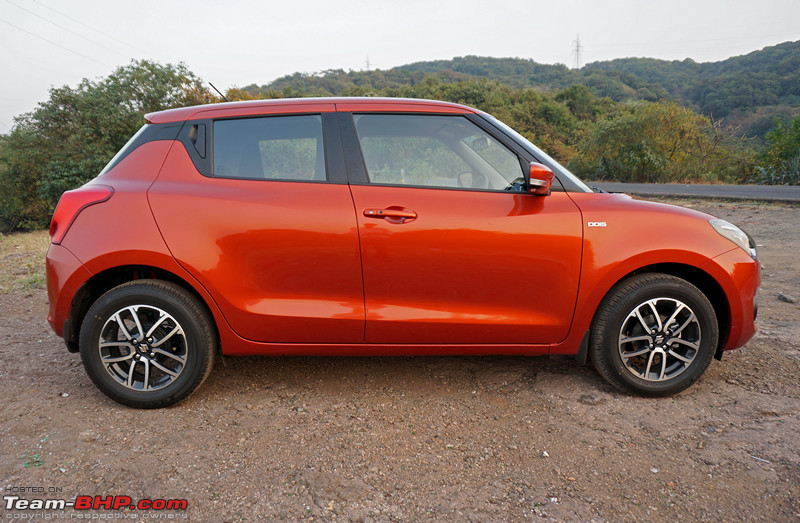 Opinions regarding the Swift's looks are divided. While I love it, Moderator Moralfibre is not a big fan of the grille design, although having a wider grille is the "in thing" now. After Hyundai, Maruti is catching up on that front: 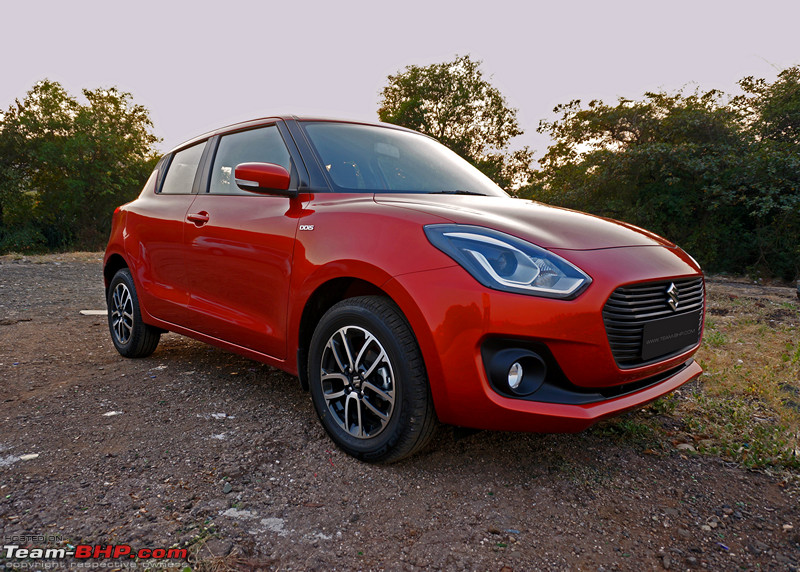 Maruti has clearly played it safe with the styling. There are no strong character lines anywhere and the wheel arches aren't excessively flared either. Chevy Beat-style rear door handle placement gives it a bit of a 3-door look, but we don't like it. This door handle went out of style a long time ago: 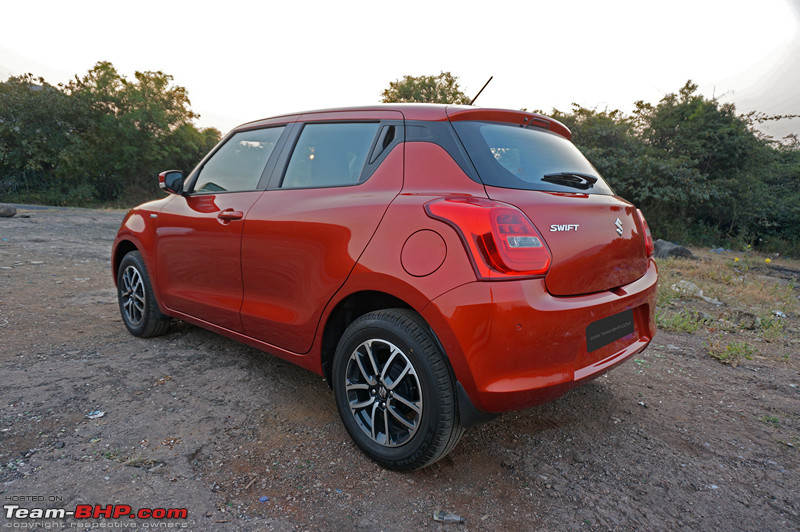 Top-end variants are equipped with automatic LED projector headlamps with black housings, along with LED U-shaped daytime running lights (DRLs) on the lower edge of the assembly. Also notice the chrome eyelid above the projector housing: 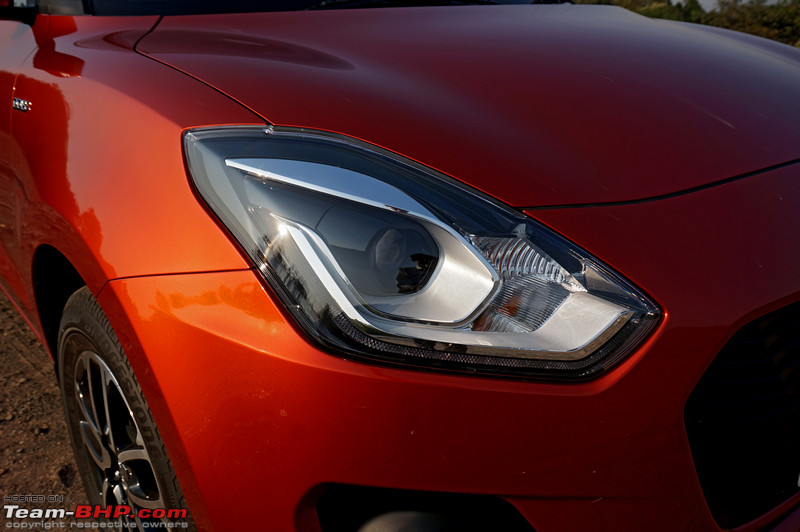 A look at the headlamp cluster with all the lights in action. Yep, the headlamps have the 'follow me home' and 'lead me to vehicle' features. Remember, these functions work only when the headlamps are in 'auto' mode. Turn-indicators are located on the inner portion of the headlamp cluster. DRLs are on all the time; switching on the pilot lamps makes them dim a little: 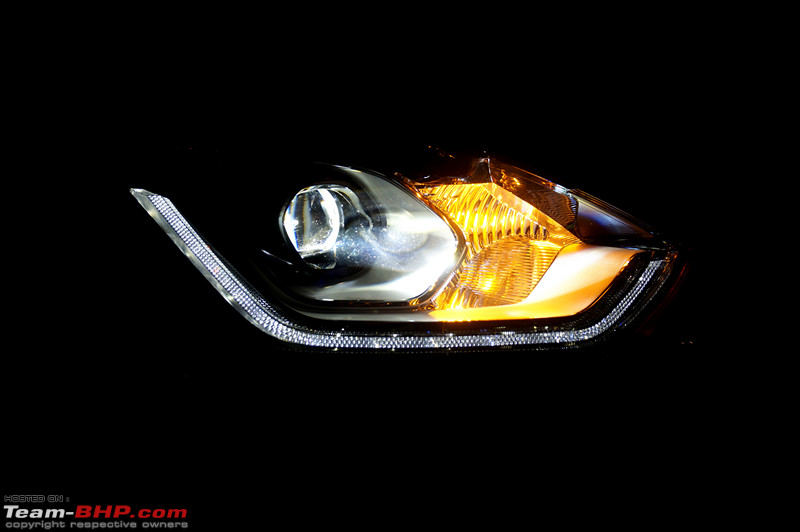 LED DRLs are bright and prominent, even under sunlight. They lend the car good road presence: 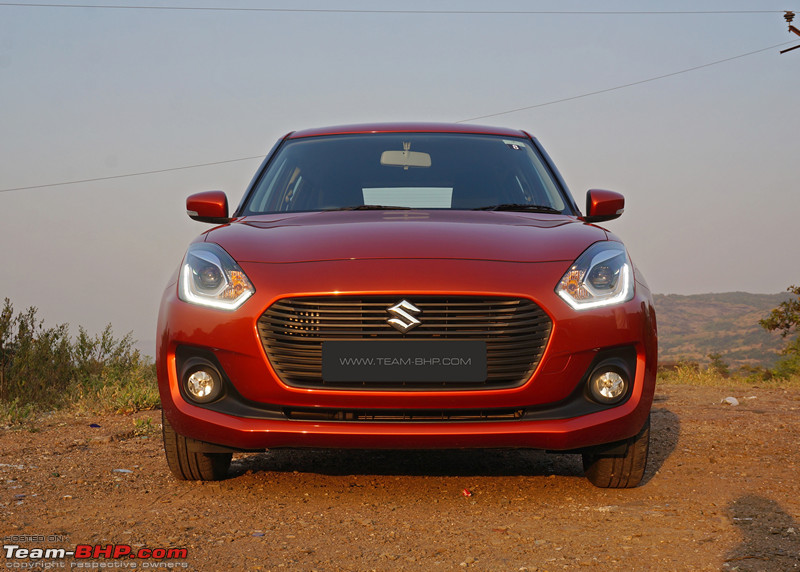 Large, hexagonal grille has multiple black horizontal slats and a large "S" logo in the center. Number plate is also screwed on to the grille itself: 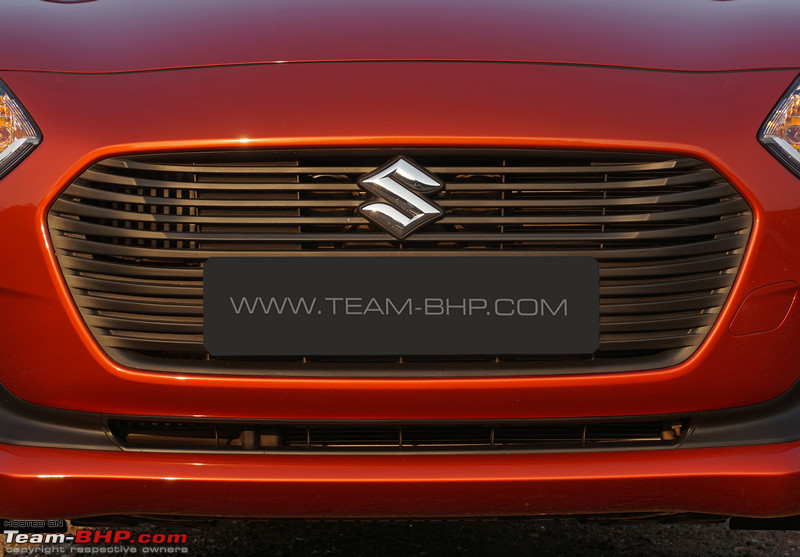 Diesel's vertically-mounted intercooler sitting next to the radiator is visible through the grille: 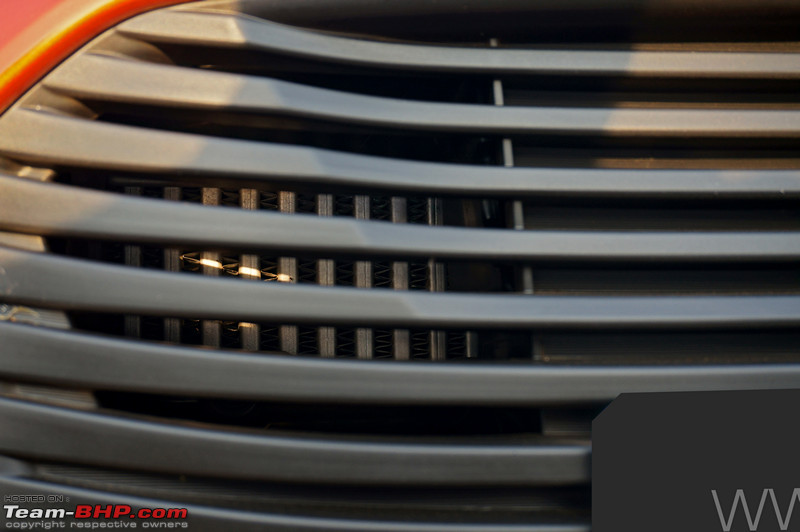 Black plastic insert runs from one foglamp housing to the other. It does a good job of breaking the bulkiness of the bumper. Unlike the Dzire, which has dollops of chrome at the front, the use of chrome in the Swift is limited to the badge. You'll see this phenomenon across manufacturers - chrome is associated with 'luxury', while the lack of it signifies 'sportiness': 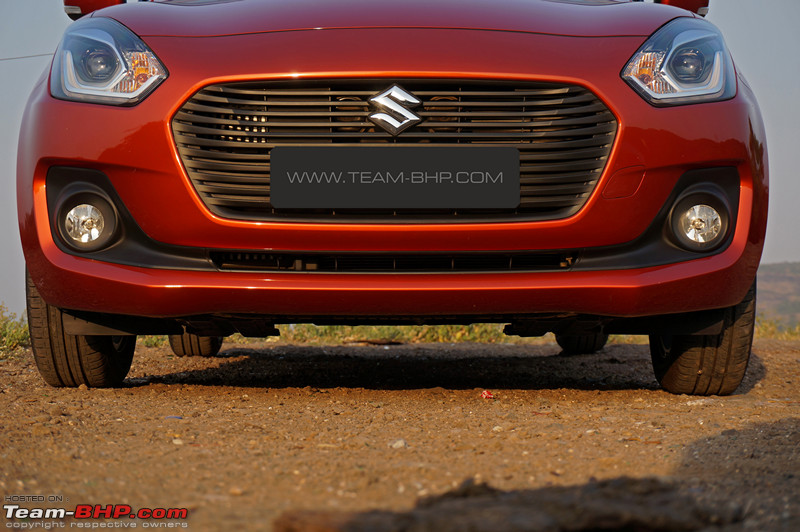 Air dam is very slim and has five vertical slats: 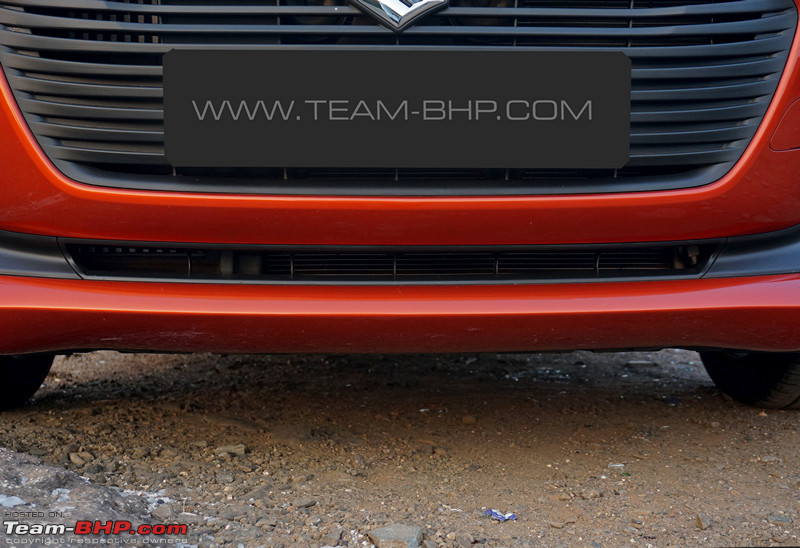 Round foglamps do a fair job of lighting up the edge of the road: 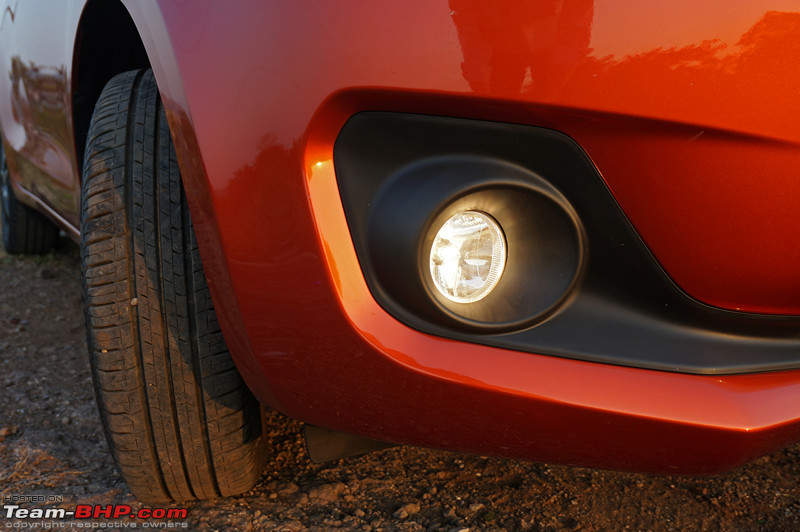 Tow hook is placed on the left side of the bumper. Nicely integrated cover, although we prefer a press-to-remove dimple on it: 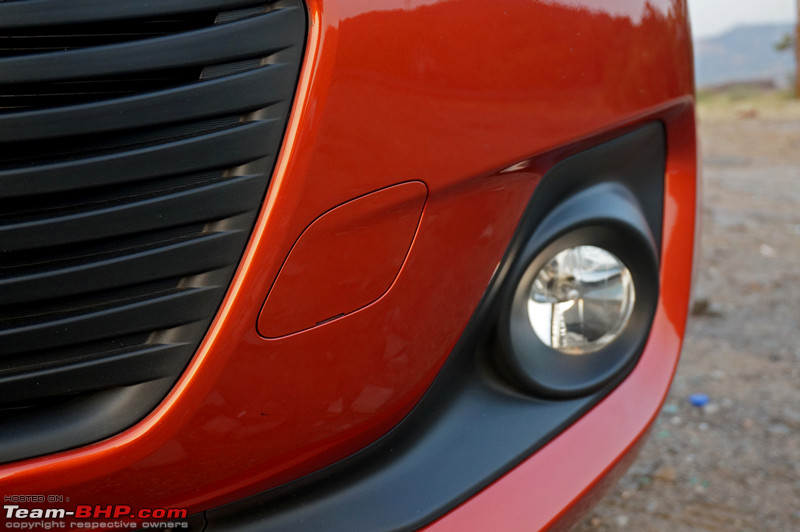 Shockingly, no underbody protection at all! Not even a plastic cover below the engine. Couple that with the unladen ground clearance of just 163 mm, and it does get concerning: 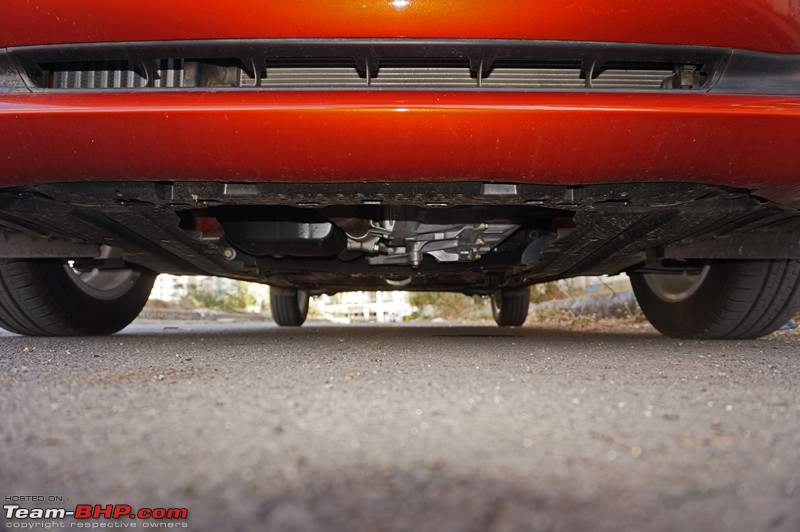 New clamshell bonnet has a smooth design with no prominent cuts or creases. The complete nose area is actually the front bumper  . The bonnet ends fairly above the front grille. As a result, in case of a mild forward collision, there are lesser chances of denting the sheet metal of the car: . The bonnet ends fairly above the front grille. As a result, in case of a mild forward collision, there are lesser chances of denting the sheet metal of the car: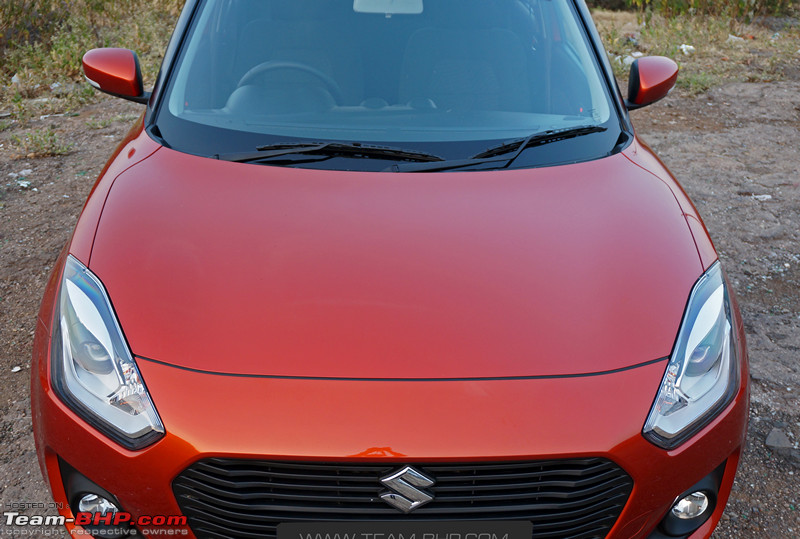 Windshield washers are well concealed under the bonnet. The two washers shoot out water through 3 nozzles each. Total of 6 jets for you: 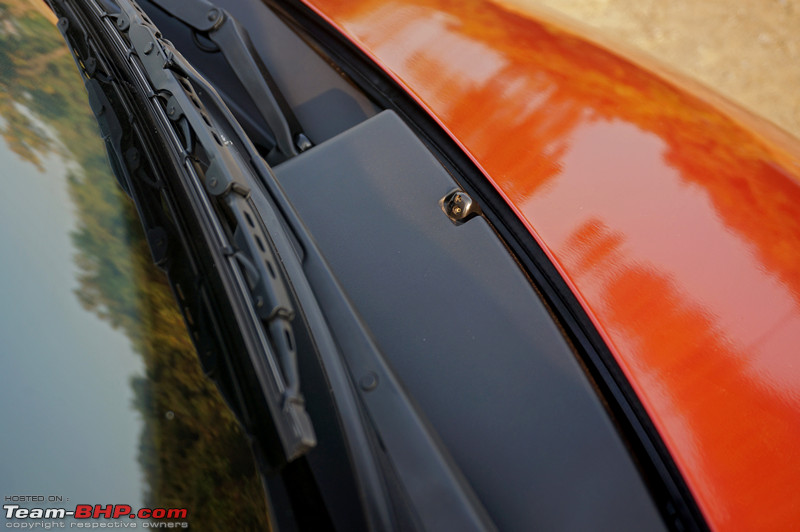 While the washer nozzles can be adjusted to alter the throw of water, I felt these wipers could have been a little bigger to cover a larger portion of the windshield: 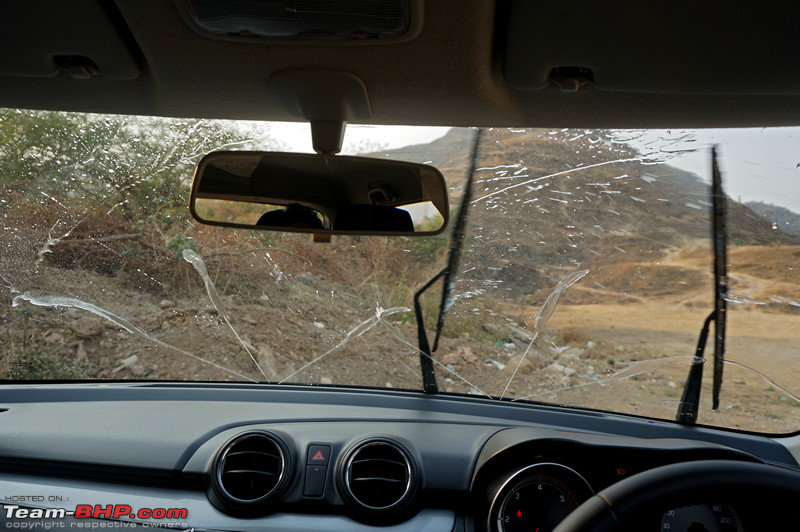 Diesel variants get DDiS badges on both front fenders. Petrol variants do not get any badge: 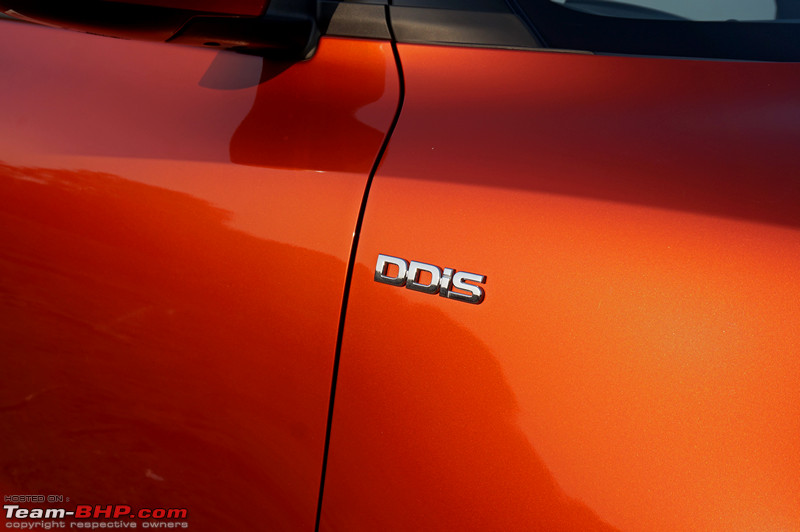 Panel gaps are consistent all over the car. But some shut lines could have been tighter: 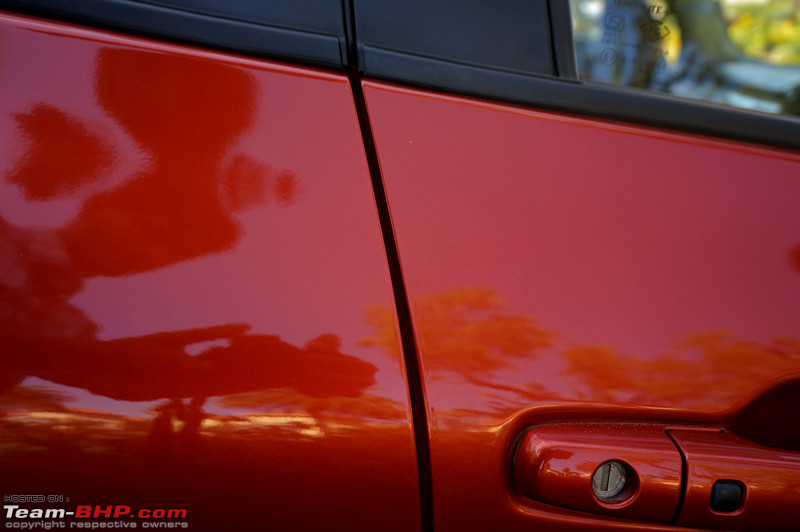 Body-coloured ORVMs are electrically-foldable and have integrated turn-indicators: 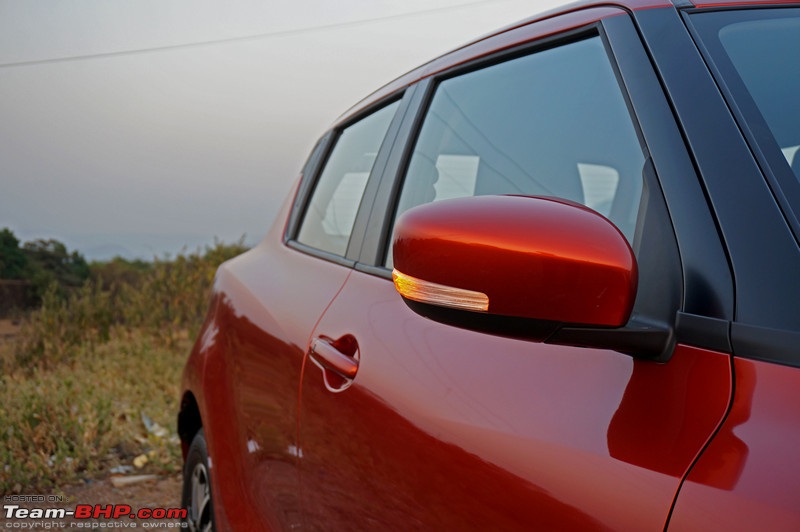 Body-coloured door handles don't feel firmly fitted and can be shaken around!!! Black request sensors on both sides, but keyhole only on the driver's: 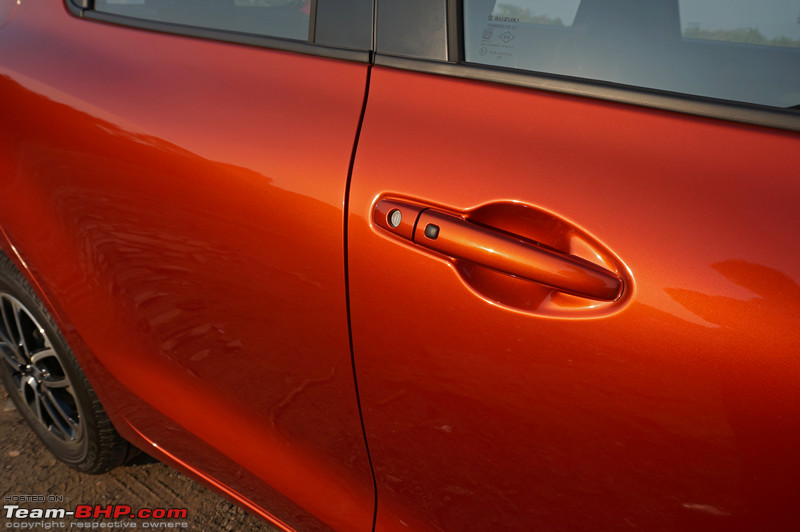 Z+ variants get 15-inch dual-tone precision cut alloy wheels with 10 spokes. 185/65 section Bridgestone Ecopia tyres are a welcome change from the MRFs and JKs that have been used on the older generation cars. They are comparatively silent performers and provide decent grip. L & V variants get 14" steel rims with 165/80 section tyres. Because they will be the most popular variants, you’ll see a lot of under-tyred Swifts on the road. 165 mm is such a poorly chosen tyre size:  Z variants get these rims. Like others in the segment, the Swift gets disc brakes at the front and drum brakes at the rear: 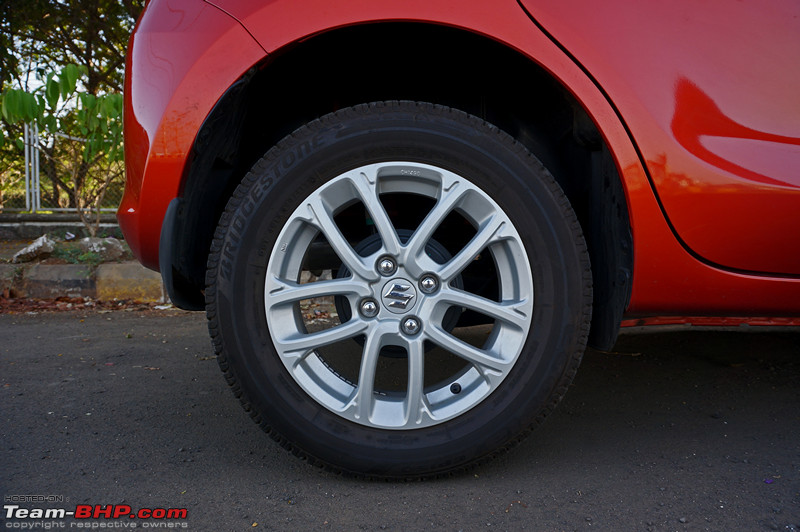 Aero flaps ahead of the front tyres... 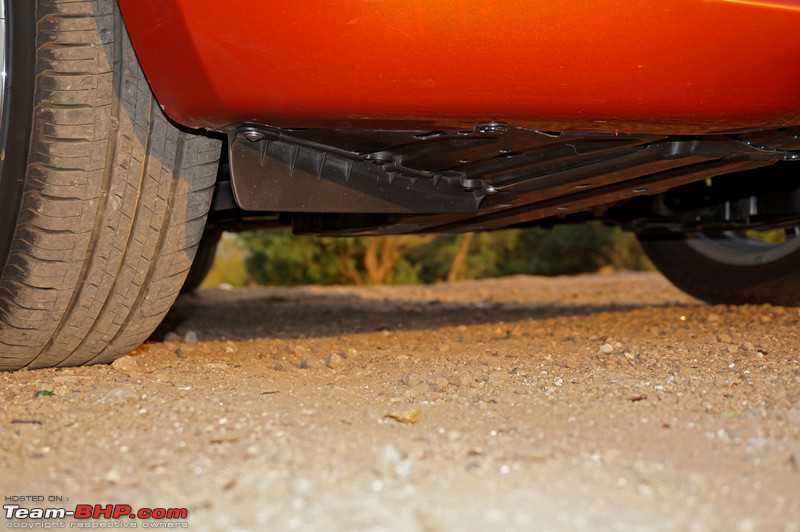 ...as well as the rear ones: 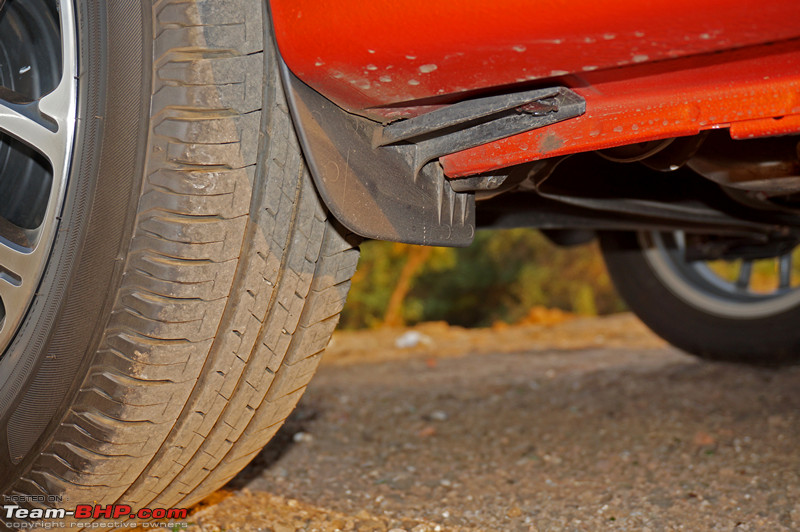 Glass area is typical Maruti. The sharply angled C-Pillar & sloping roof look great, but they chew away rear headroom. Window line rises toward the rear, which means the glass area isn't large to start with. That, along with the black plastic panel (on which the rear door handle is mounted), further reduces the glass area at the back. Classic example of form over function. Like the outgoing car, the A and B-Pillars are blackened:  In a first for a Maruti car, the rear door handles have been placed on the window rather than the door (like the Chevrolet Beat and Mahindra KUV100). These went out of style a while back and shouldn't have been used. Personally, I am not a fan of this design and the black handle within a black housing means that the older generation will be confused while trying to locate it. I had to get off from the driver's seat to show Dad where it was. A black plastic panel on the C-Pillar has been used to create the 'floating roof' effect. It is slim and does not black out the entire pillar: 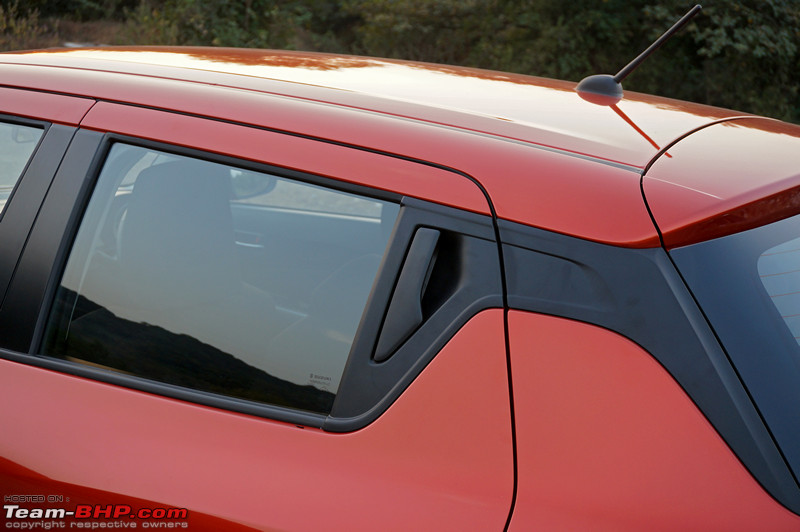 Notice how the black plastic panel on the C-Pillar merges with the rear windshield: 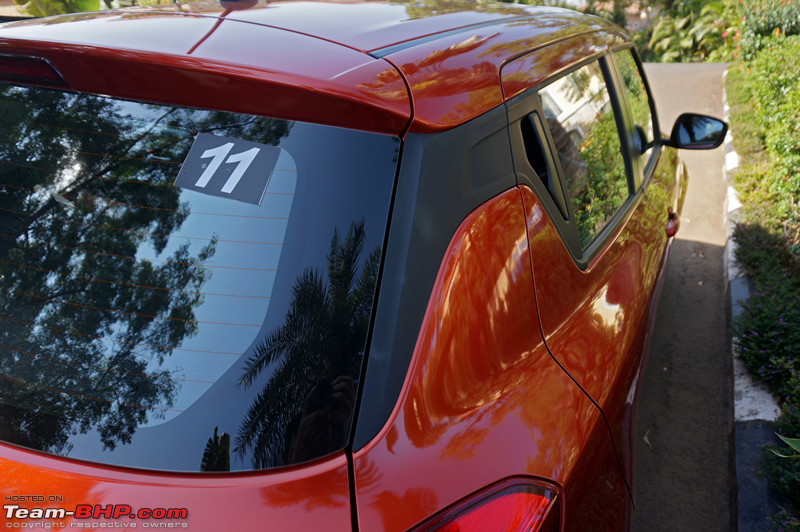 Considering the light weight nature of the car, I'd have expected a ribbed roof for additional rigidity: 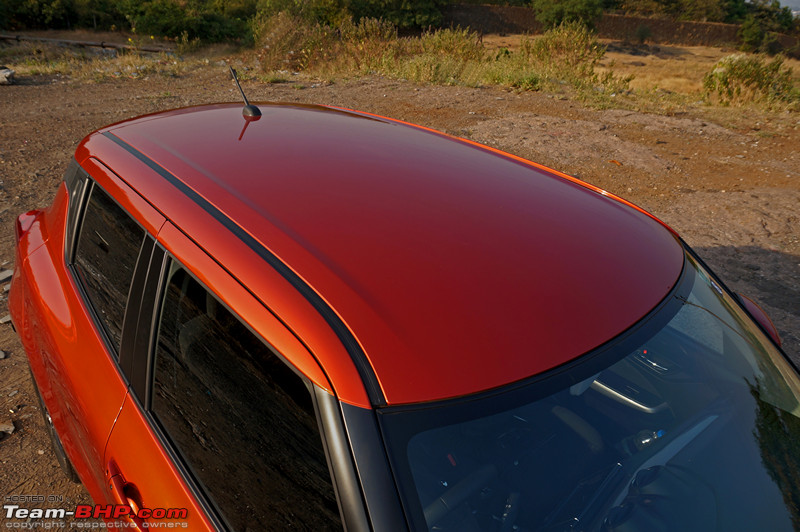 Short & stubby antenna located towards the rear of the car: 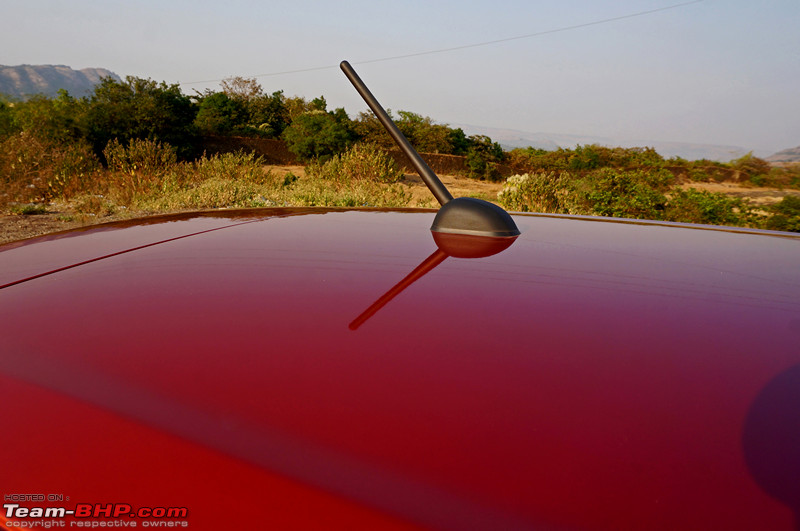 New wraparound front-sweeping tail-lamp clusters get LED light guides (pilot lamps) and reflectors. No rear foglamps have been provided: 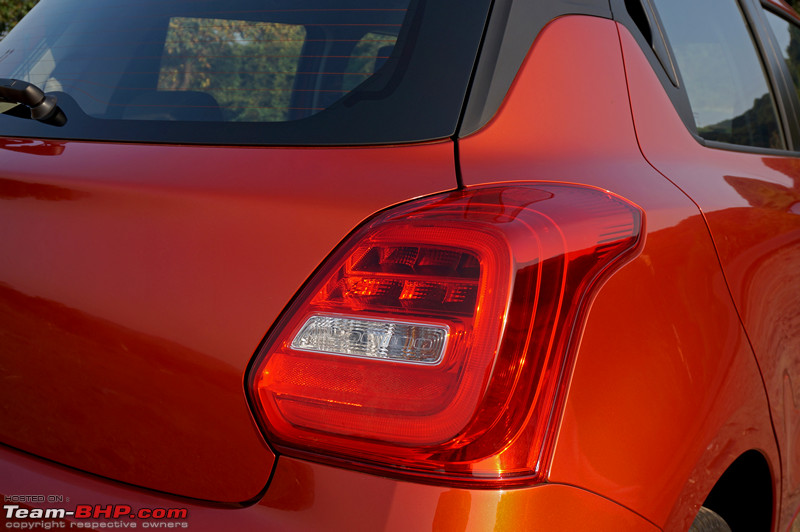 Notice how the tail-lamps stick out at the ends: 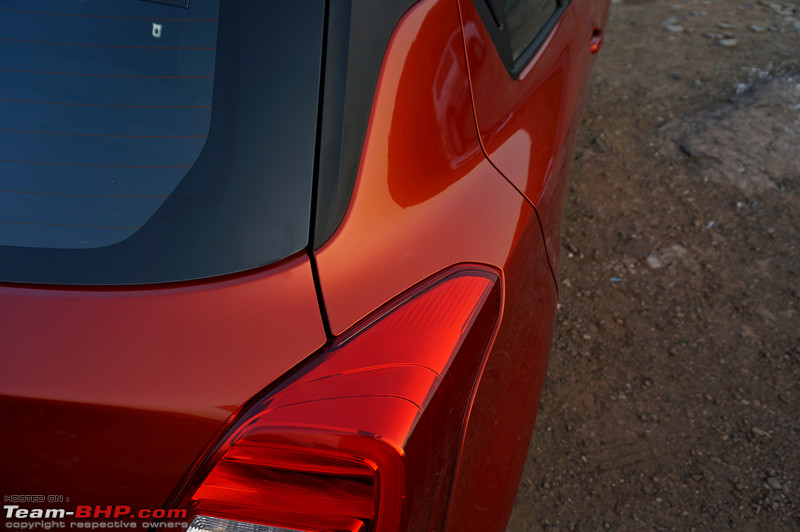 Zooming in on their detailing: 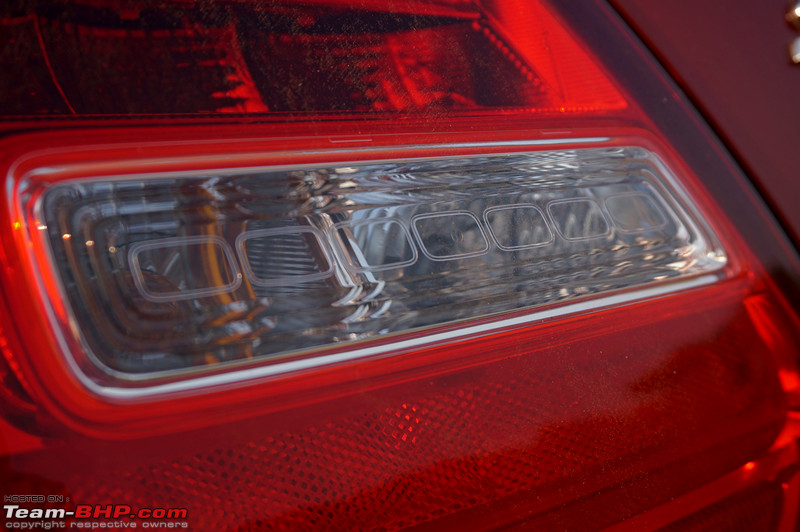 A look at the tail-lamp cluster in action. C-shaped LED light guides around the outer edges come on with the follow-me-home feature. Reversing lamps are provided in both tail-lamp clusters (reversing + turning lights get regular bulbs, not LEDs). Turn-indicators blink once on locking and twice on unlocking the car. Braking lights have multiple LEDs housed above the turn-indicators and reversing lamps: 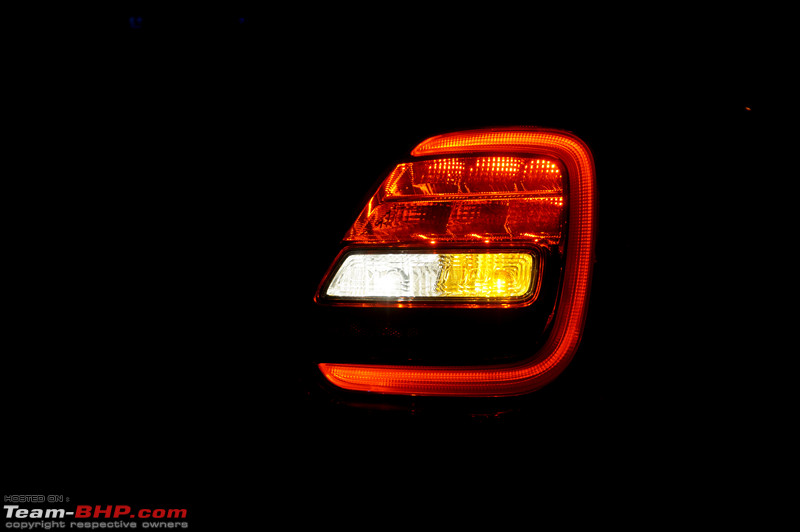 Tailgate gets a neatly integrated spoiler: 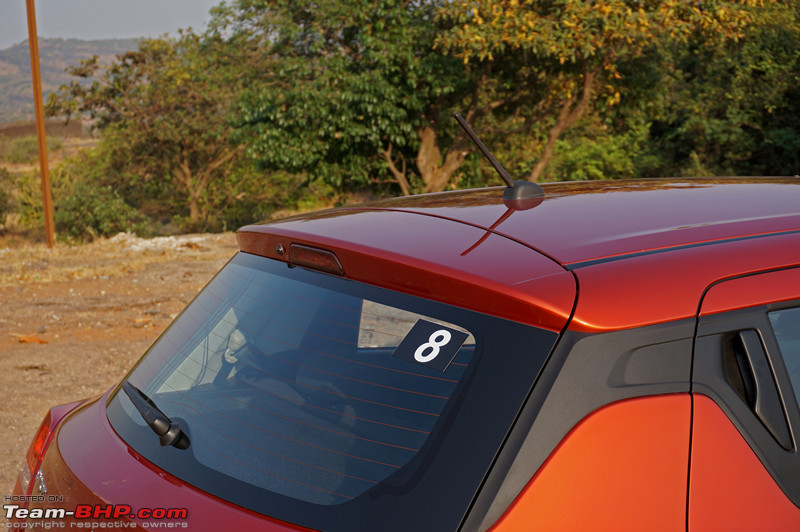 The HMSL on the rear spoiler. However, the black windshield washer sticks out and could have been better integrated: 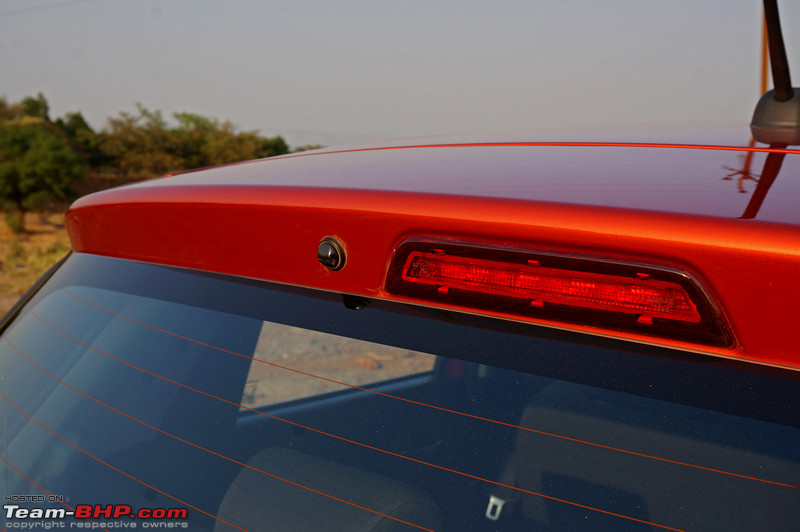 Chrome "Swift" badge is pasted on the left. There is no badge indicating the transmission or variant of the car anywhere. There's also no 'Maruti" badging on the car! Talk about confidence in brand 'Swift': 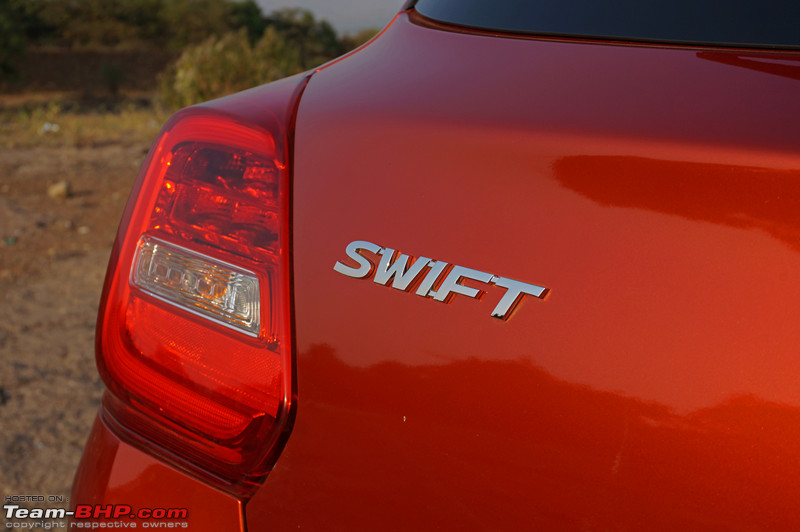 The tail-lamp's integration with the hatch is not great - you will see a wider gap here than along other panels:  Rear wiper is provided only on the Z and Z+ variants. Should have been standard on all variants as it's an important safety feature. Wiper is small and just about does the job. Can't have a larger unit due to the windscreen's limited height: 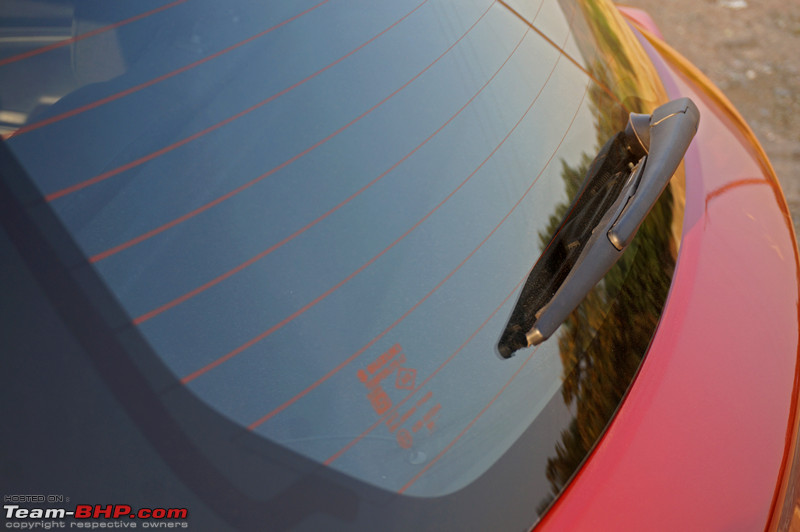 Portion of the tailgate below the windscreen forms a sort of a lip: 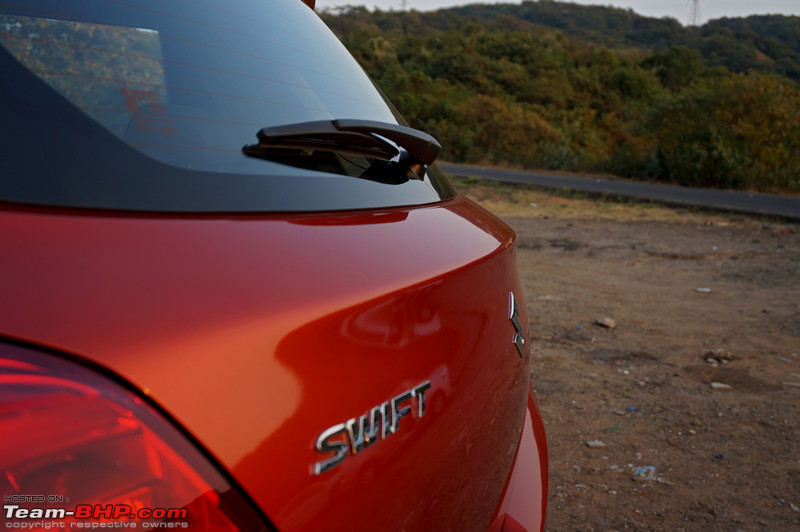 The old Swift had a bloated rear bumper with no metal under the skin to protect it from getting dented. Rear endings would mean expensive replacements & paint jobs. In the new car, the bumper does not feel as hollow upon knocking. That may save you from large repair bills. The bumper has a big number plate housing and 4 parking sensors. Good to see 4 parking sensors on a B2 segment hatchback at a time when some 20 lakh cars give merely two (pic of Innova Crysta). Notice the cutout at the top which gives access to the boot release: 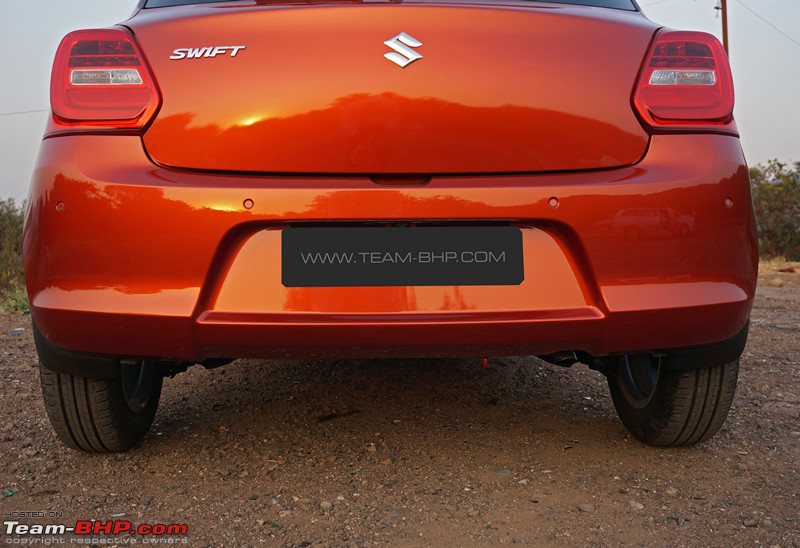 Z+ variant gets a small reversing camera, which is well integrated and sits at the top of the number plate housing: 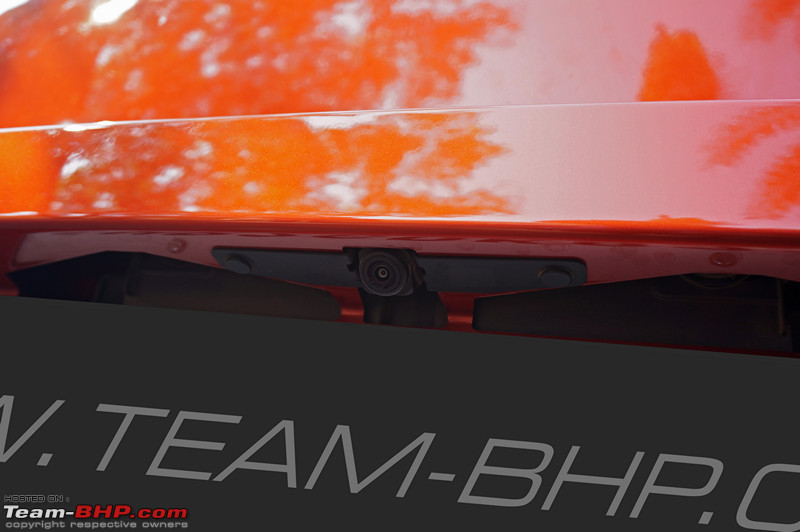 Boot release on the left with the small 'lock / unlock' button on the right. With the smartkey in your pocket, simply press the unlock button, followed by the boot release to open the tailgate: 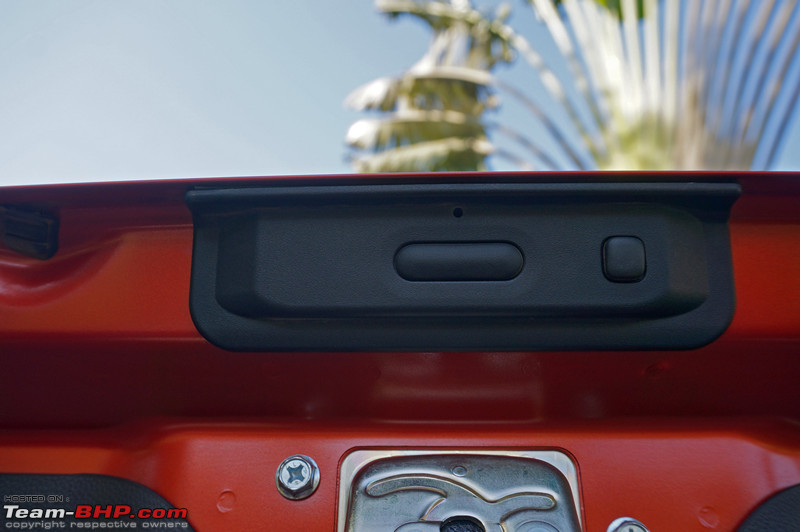 Gets a ubiquitous McPherson suspension setup at the front and... 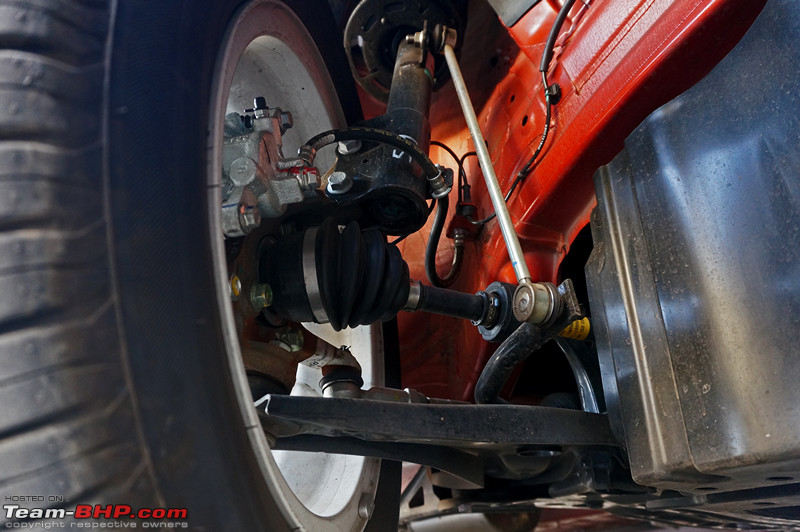 ...a torsion beam setup at the rear: 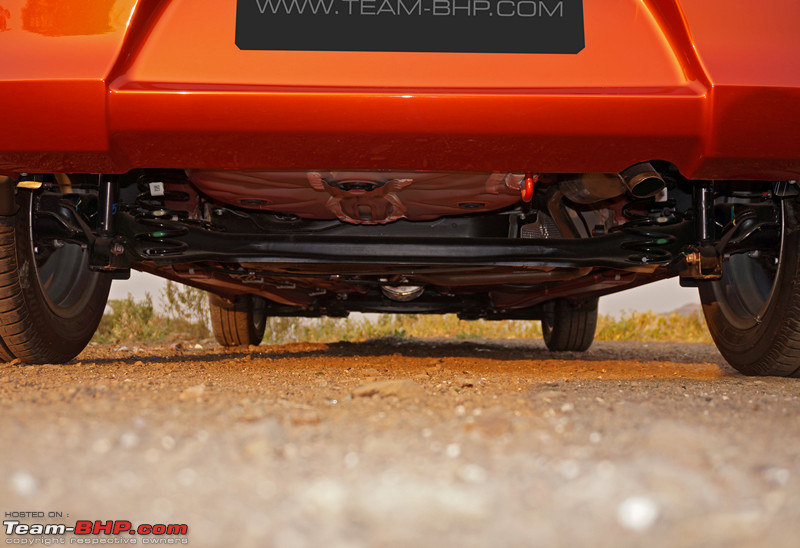 Tow-eye and tail pipe are located on the right. Notice the bumper cutout where the exhaust peeps out: 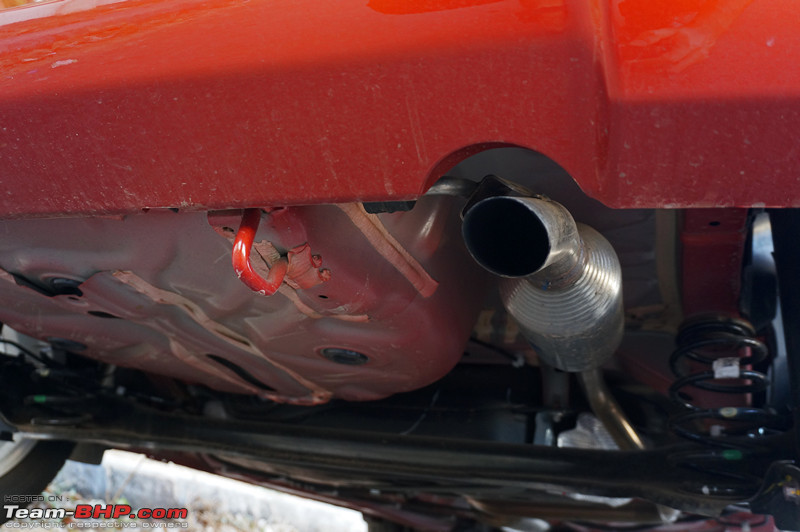 The new Swift appears more planted than the outgoing model. While it stands just as high as the old car, it is the increased width that gives us this feeling. There is not much resemblance between the two cars due to the new headlights and grille: 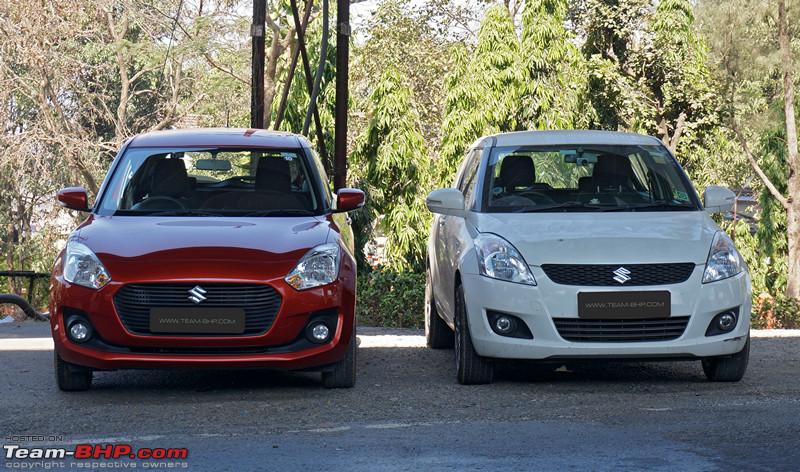 Rear styling theme is very different too: 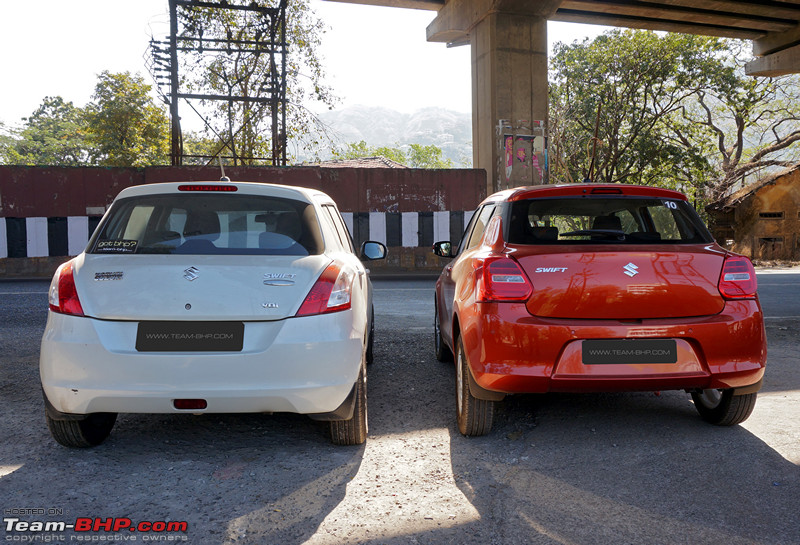 Bonnet of the new car appears more squarish as compared to the old car. Notice how much more the 2nd-gen car's headlights sweep back in comparison. The glass area has reduced with time and the rear quarter glass has been dropped. The hatch of the new car sticks out more: 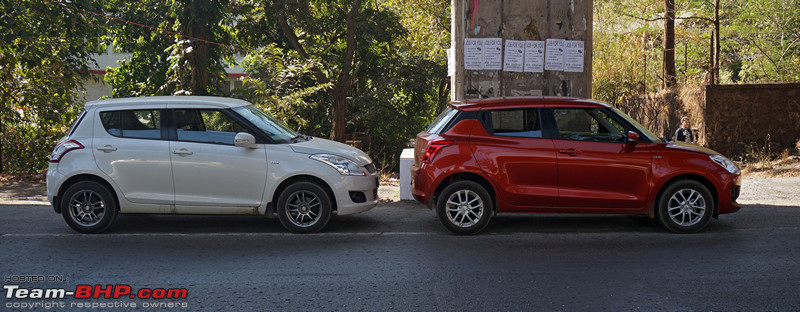 Last edited by Aditya : 26th April 2018 at 12:57. |
| |  (48)
Thanks (48)
Thanks
 |
| The following 48 BHPians Thank Aditya for this useful post: | 2himanshu, AltoLXI, Avikbrio, BlackPearl, CarguyNish, carrazy, chiranjitp, dailydriver, darklord, dkaile, DrANTO, espraveen, Gannu_1, GTO, InControl, lemedico, Leoshashi, libranof1987, moralfibre, N33raj, Nimalan, Nohonking, Obi-Wan, Ponbaarathi, Rambo-RS, Researcher, romeomidhun, rshanker, S.MJet, sainyamk95, samabhi, sdp1975, Sheel, shreyak_ss, SnS_12, sri2012, suhaas307, sukiwa, sunny29584, swiftnfurious, theexperthand, TusharK, uday.ere, vaasu, Varun_HexaGuy, vb-saan, VeluM, Vik0728 |
| | #4 |
| Team-BHP Support  | Interior - Front 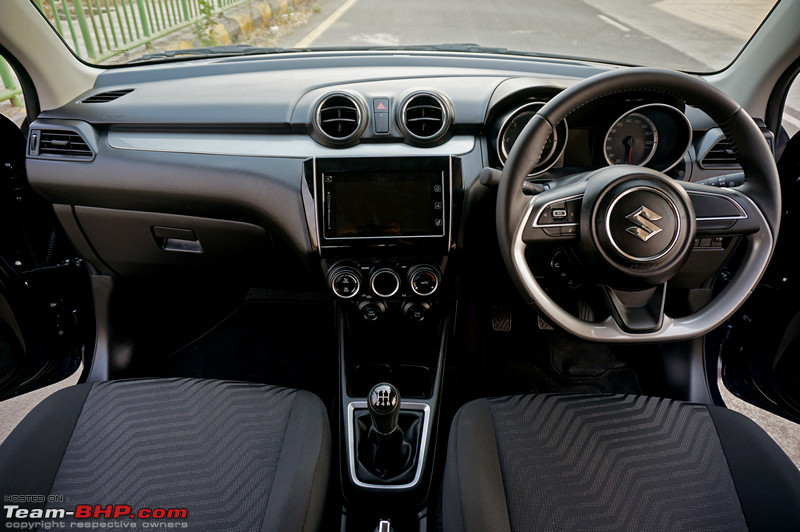 The front doors open and shut in a triple-stage action. You immediately realise how light they are - a reminder of how less the Swift weighs. There is certainly no "European thud" when you shut the doors. The doors open wide enough and the running board is not wide either. However, while the floor of the car is not high, the roof is on the lower side, so you have to bend a bit to get in. This is very noticeable if the driver's seat is at a lower position. Ergonomically, the cabin is properly laid out and all controls are easy to find and reach. There’s good legroom and headroom at the front. Since the car is wider than before, shoulder room at the front has increased by 23 mm. The dashboard has a neutral design as we have seen in most Maruti cars - everyone will like it. It has an all-black theme with silver inserts (unlike the Dzire's beige). Piano black has been used on the center fascia, around the now-familiar touchscreen infotainment system. The design of the dashboard is based on the Dzire's unit. However, there are some differences. The air-conditioner vents at the top of the center console are round and the climate control console is different as well. Just like the exterior, Maruti has tried to make the interior a bit sportier than the Dzire (black cabin, round vents + console, red instrument cluster rims, silver inserts instead of wood...). The seat upholstery, doorpads and even the carpets are black. This treatment could make the interior of the car claustrophobic for many folks. However, it is unlikely to get soiled easily and in the long run, will be easier to keep clean compared to beige. The fab-looking, leather-wrapped, flat-bottom steering wheel is identical in design to the Dzire's. However, like the rest of the interior, it is a black unit with a silver insert. The plastics on the dashboard are all hard. While the fit is satisfactory with no sharp edges or ill-fitted items, the overall quality of the plastics is strictly average and nowhere at par with the likes of say, the VW Polo or Hyundai Grand i10. That said, the quality of the cabin is a step above the outgoing car's - Moralfibre (owner of the last-gen) confirmed this. While some of the switchgear is taken from other Maruti cars, most of the buttons and switches feel good to use and appear durable. All-black dashboard looks decidedly sportier than the Dzire's black & beige unit. It will be easier to keep clean as well. Silver inserts have been added on the dashboard. Interiors are well-designed and the ergonomics are spot on with all controls falling easily to hand:  Dashboard is well-screwed together and nicely finished. The plastics are definitely nicer than the outgoing car with no harsh or rough edges, but they aren't at the Hyundai or VW level. Also, like a typical Maruti, we could hear rattles that had settled in with just 700 km on the test car's odometer  : : Driving position is user-friendly. Large windshield offers a clean view of the road ahead. Dash isn’t high at all – always a good thing for frontward visibility:  Sexy leather-wrapped, flat-bottom steering with thumb contours and silver + chrome. It's awesome to hold. Horn pad is not easy to reach for people with small fingers, but it is light to press:  Buttons for controlling the audio system are located on the left spoke and feel premium to use. The volume and source can now be changed via a toggle switch. Mute button is useful (does not pause the song that is being played - it kills the sound). All buttons offer satisfactory haptic feedback:  Voice control and telephony buttons are located below; should be pushed from the back to operate:  Zooming in to show you the stitching pattern of the steering. Steering thickness is just perfect:  Silver insert on the lower part of the steering gives it a sporty look. Enthusiasts are sure to prefer this to the faux wood treatment seen in the Dzire. It's not glossy (saying this in a good way):  Steering can be adjusted for height only, not for reach...even in the top spec. A big miss as the Baleno has it  : : New twin-pod instrument cluster is clear and easy to read. I like the classy silver rings (prefer it over chrome). Fonts are well-sized and the dials get red needles. The borders of the dials light up in red when the engine is switched on - very cool (looks absolutely fantastic at night). The area above the MID houses the warning lights and indicators. Sadly, no temperature gauge provided. Rev counter on the left & speedometer on the right (just the way we prefer it):  U-g-l-y stalk to adjust the trip meter sticks out of the instrument cluster on the left. Should have just had a button for this function:  Yet another ugly stalk on the right to adjust the brightness of the instrument cluster. Long press it to enter 'settings'. Twist it to the right or left to toggle between the functions and then, short press to select a function:  Tachometer of the diesel is marked till 6,000 rpm. Needles point down at their rest position (seen in some sports cars):  MID is black + white and relatively simple. Wish it got the sweet colour MID of the Baleno though (international Swift gets one). Still, it provides adequate information, including bars for the fuel gauge, with digital read-outs for the odometer, time, outside temperature, two trip meters, a range / DTE counter and average + instant fuel economy:  Outdated fonts make us believe that Suzuki engineers walked over to the Casio office in Japan asking for suggestions. In the MT, a large portion of the MID remains blank. Settings include shock sensors (anti-theft system), timing of the follow-me-home lights, turn-indicator flashes (lane change) and door locking system:  The AMT version gets a large gear indicator in the middle. Illumination of the instrument cluster and MID can be adjusted in 6 steps. The brightness of other controls such as the air-con system, parking sensor button and engine start / stop button is also altered:  Chunky wiper and light stalks. Turn-indicators have a 'lane change' feature, which makes them flash thrice when the stalk is tapped lightly. While automatic headlamps have been provided, automatic wipers have been left out of the feature list:  Standard chrome-ringed engine start button from the Maruti parts bin is located on the right of the steering wheel. Button looks boring - Maruti should have chosen something better:  Side air-con vents should have had some silver highlights for character; all-black look is dull. Air flow volume can be adjusted or shut:  The 'parking sensor enable/disable' button (pointless IMHO) and headlight leveller sit below the engine start button. If you disable the parking sensors, the camera still works (rightly so). Foglamp switch is located on the light stalk. Too many blanks in a car that has become more premium. It's like Maruti reminding you "you could've had 6 features, but we're only giving 2"!  Bonnet release lever looks ugly, but feels sturdy:  Like the dashboard, the doorpads get an all-black colour theme. It will not get soiled easily. While the plastics are all hard, the area above the armrest and power window console gets a soft fabric insert. Even the armrest is padded and covered in fabric (not on the rear doors though). There is very little flex in the doorpad and there is very little movement when the windows are rolled down or up. Honda listening?  Door handles are finished in chrome and remain identical to the old car's. They don't feel robust and have a flimsy + springy action. On a related note, the door lock/unlock sound is loud. The car has auto-locking as well as auto-unlocking (when you switch the car off) doors:  Standard Maruti console that we've been seeing since ages. Maruti team obviously has some kind of emotional attachment to this piece. It's an eyesore and doesn’t feel nice to use either – very utilitarian in design & feel. Only driver's window gets one-touch up & down and anti-pinch functionality. Only the driver's window button is illuminated. Door mirrors are electrically foldable: 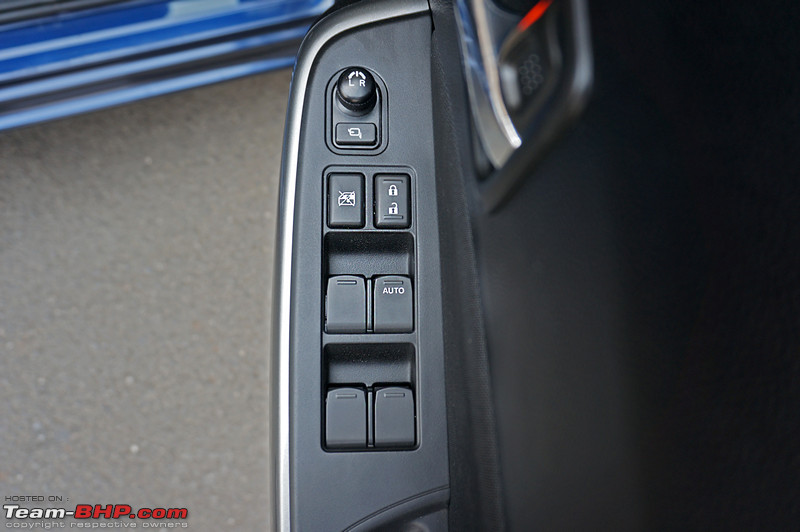 Silver insert adds a bit of contrast to the all-black doorpad. Front door armrests are padded and covered in fabric at the place where you rest your elbow:  Door pockets are not particularly wide. Can hold a 1L bottle and other small items:  Door sills aren't fat, which means lesser effort is needed to move your feet in & out of the car. No scuff plates provided: 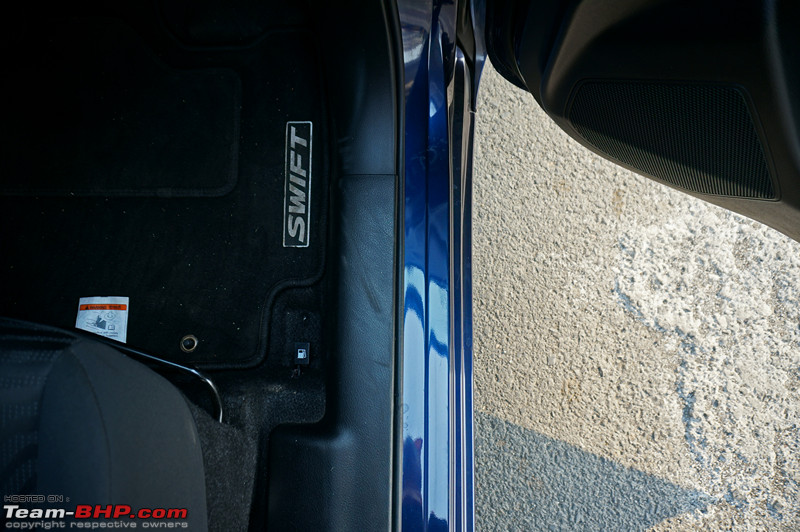 Front seats are wonderfully-shaped and provide good support. Side bolstering is healthy and there is sufficient padding. Seats are slightly towards the softer side and may not be the best for long highway journeys. They are wide enough for most occupants and the cabin width ensures that occupants don't feel too close to each other. The neck restraints are very tall (look weird!) while their cushioning is on the firmer side. Quality of this fabric upholstery is satisfactory:  Lever to recline the seat feels loose, and neither lever feels very durable. Height adjustment for the driver's seat is there in the mid-variant too. Good for shorter folk:  Fore & aft adjustment via this sturdy metal lever:  Fore & aft travel range is enough to allow even 6 footers to be comfortable:  Height adjustment range is healthy as well. Short or tall, no one will complain:  Big headrests are nice. They look a bit weird though and are reminiscent of the ones in the jellybean Zen (from the 90s). Coupled with the B-Pillar, the left headrest forms a big blind spot for the driver at intersections. The thick C-Pillar only makes matters worse as there is just a small opening for the driver to see out of. In this image, you can clearly see how the upper half of the cabin has been given a lighter shade (a good idea):  A close look at the upholstery pattern:  Seatbelts are not height-adjustable. However, they are placed at a comfortable height and will suit most occupants. They get pretensioners & force limiters:  The standard Maruti A, B, C pedals aren't spaced out wide. No dead pedal provided, yet there's just enough space to rest your foot to the left of the clutch:  Fuel flap release is located on the floor, just ahead of the driver's seat. Notice how the floor mat is designed to ensure that it doesn’t foul with it. No boot release here. The hatch locks / unlocks with the central locking system:  Shape of the ORVMs is identical to other Marutis. They are sufficiently tall, although I'd have liked them to be a li'l wider: 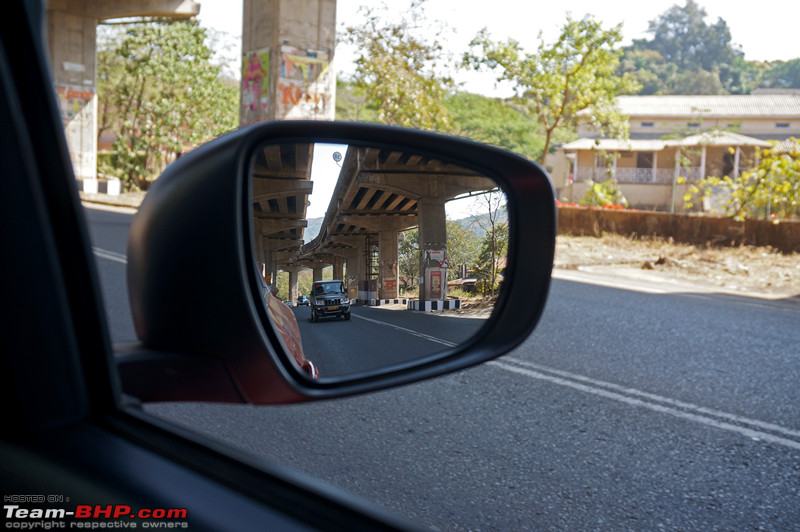 IRVM is wide enough to cover the entire rear windshield, but the thick C-Pillars and small rear windshield restrict visibility. It doesn't get auto-dimming functionality either - a disappointing omission in a car that's now so nicely kitted!  Rearward visibility is very poor. C-Pillars are thick & glass area is small. Thankfully, Maruti has provided a reversing camera (in the Z+ variant) and 4 parking sensors (Z & Z+):  Center fascia is tilted toward the driver. Piano black paneling has been used around the infotainment system:  The center air-con vents are round in shape (unlike the Dzire). They also feature subtle chrome borders. No air volume adjustment provided here:  Even with the vents shut, a considerable amount of air keeps flowing out:  7-inch tablet-like touchscreen ICE has Bluetooth, USB and Aux-in connectivity, and further supports Android Auto, Apple CarPlay & MirrorLink. Very convenient. Gets an SD Card slot for navigation as well. Its functions have been covered in a dedicated post later in the review:  Touchscreen infotainment system neatly protrudes out of the center fascia and is far better integrated into the dashboard than the Ignis' unit. Sticks out only at the top:  Simple and easy-to-read climate control system gets cool circular dials with silver inserts. While the blower speed can be adjusted by using the dial on the left, the temperature can be altered by using the dial on the right. The center dial acts as a display only. The blower has 8 levels of adjustment. At levels 1 and 2, it is silent. At levels 3 and 4, it gets audible. At levels 5 and 6, it is loud, while on levels 7 and 8 - the noise is excessive. The lowest temperature that the system goes to is 18 degrees centigrade before hitting 'LO', while the highest temperature level is 32 before hitting 'HI'. The cooling performance is excellent. Even in sweltering hot Bombay, the interiors were chilled quickly:  12V power outlet and USB + Aux ports are located below the climate control system on the center fascia. Both are identically styled & get flip-up plastic covers. Cool looking for sure:  A parking spot for your smartphone:  Center console gets a pair of cupholders. Nope, that's not rubber lining on the base:  Gear lever looks sexy with a glossy black insert on the top and letters etched on it. It is soft and very good to hold. Throw is short and slick. Don't miss the silver border around the console: 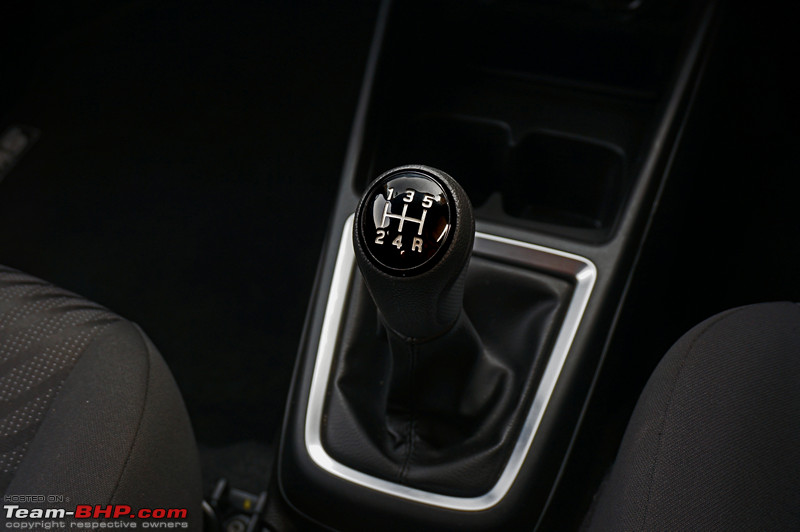 A closer look at the perforated detailing on the knob: 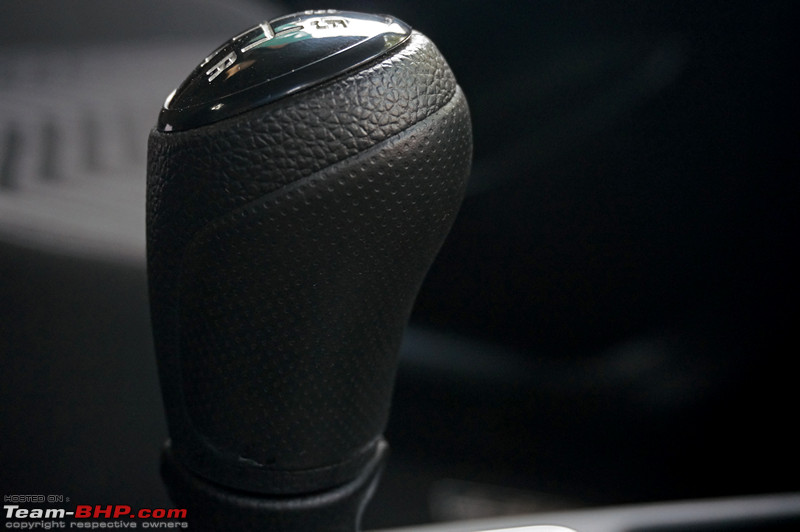 Bird's eye view of the handbrake console. Sadly, no center armrest provided for the driver. This is sorely missed, particularly in the AMT variants. A wrong omission by Maruti: 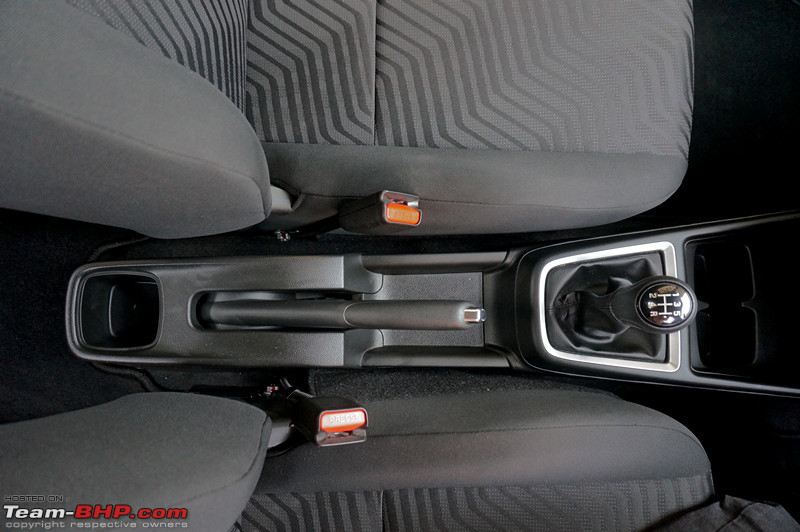 Shallow area below the handbrake can hold a 5.5" smartphone: 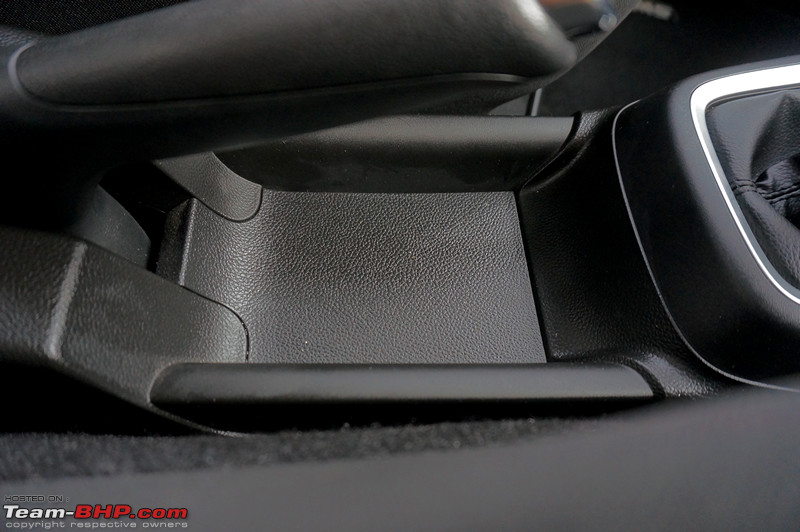 All variants get dual front airbags as standard: 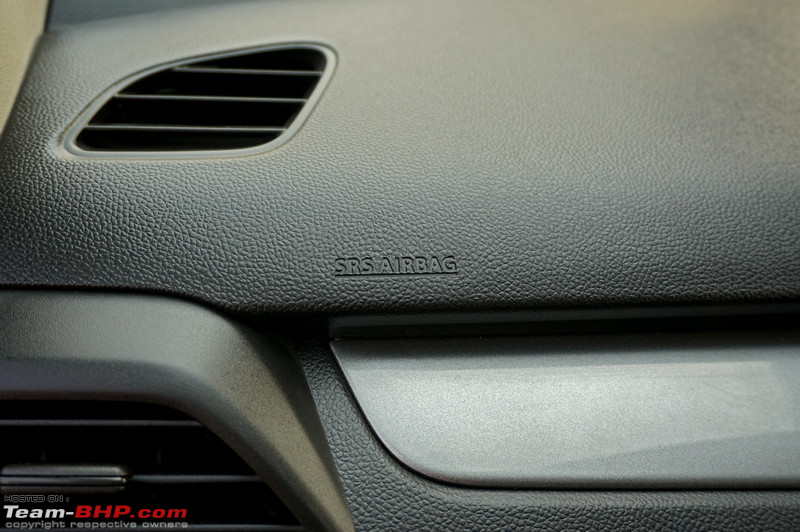 Silver insert looks very tasteful and helps in breaking the monotony: 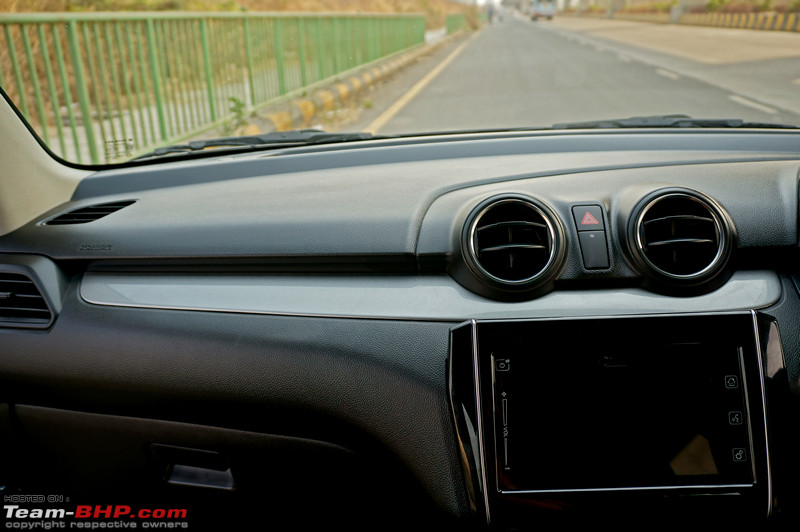 The dash is scooped in on the left side, thus freeing up more knee space for the front passenger: 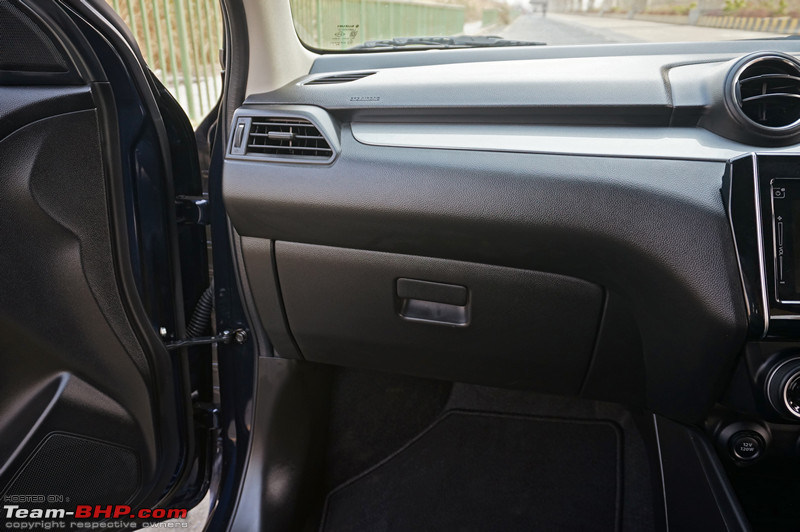 Glovebox is on the smaller side. Neither is it deep, nor does it have compartments, illumination or cooling. Additionally, the lid feels too thin & plasticky and takes a couple of tries to close properly. The damping could be improved as well because you can hear the lid rattling as you drive along: 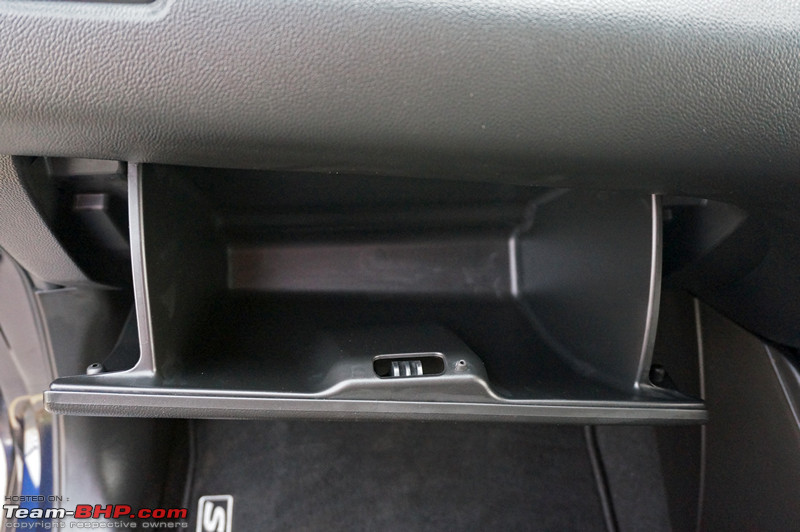 Cupholder ahead of the side vent in the ol’ Swift (reference image) will be missed by some: 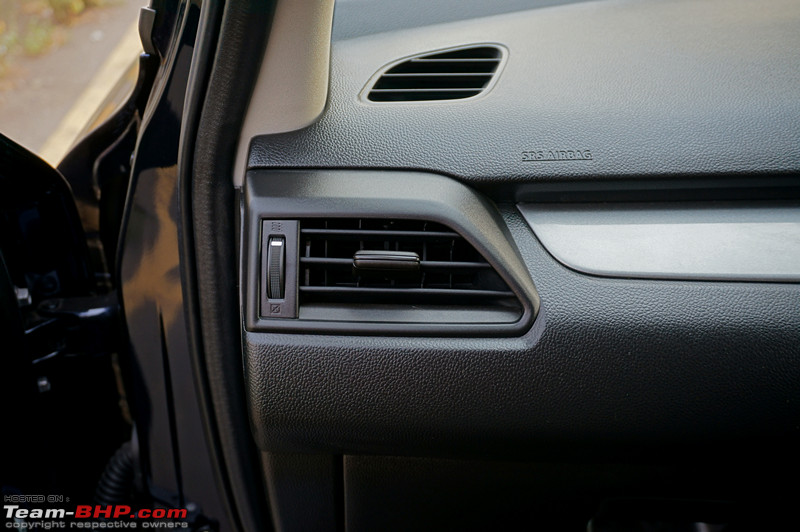 Wheel well intrudes into the footwell restricting the co-driver's foot space: 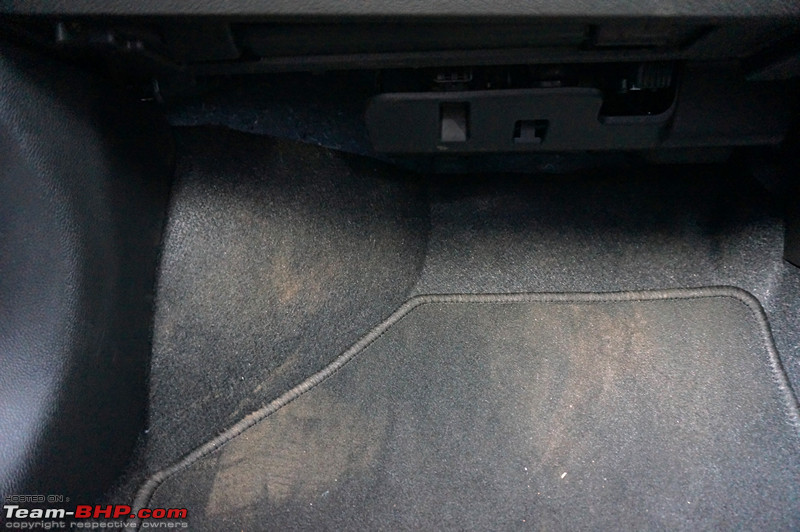 Things are generally tidy below the dashboard, with no loose wires or parts dangling about: 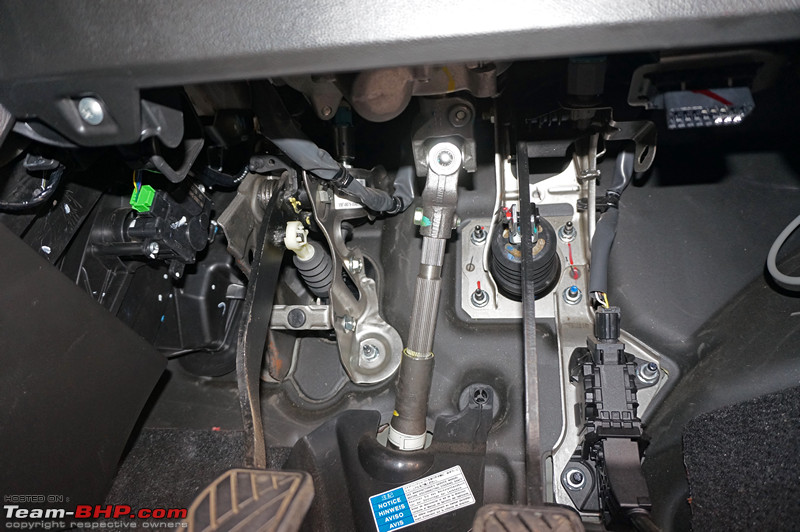 Passenger side gets a small cover as well. It looks like a trim to cover the blower fan: 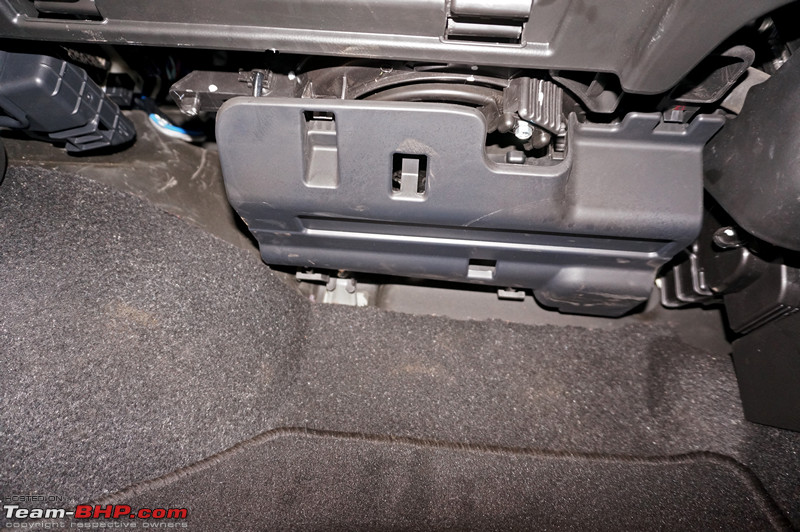 A single cabin light only at the front, with no individual map lights either. If you’re going to give only one light in the cabin, it should have been in the center (just above the front seats) so both front + rear passengers can operate it. The cluster also houses the Bluetooth mic: 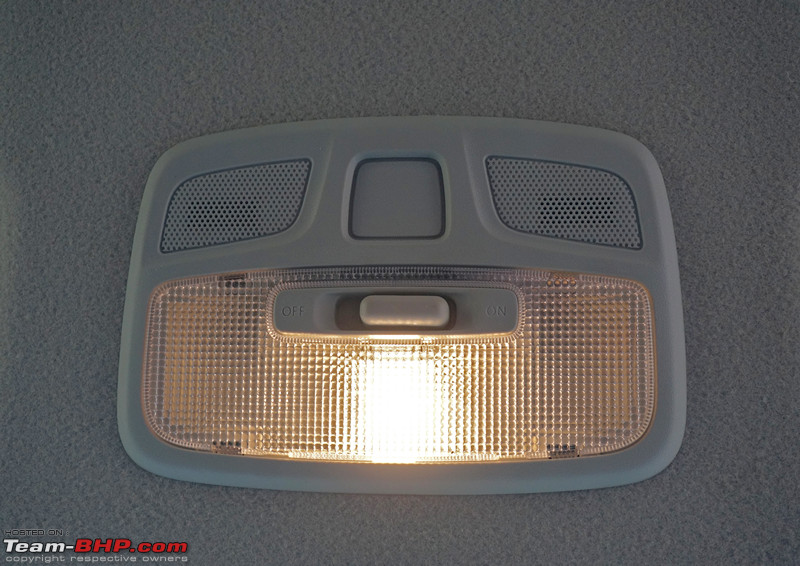 Sunvisors are economy-grade in design & feel. Driver-side unit merely gets a flap to hold tickets: 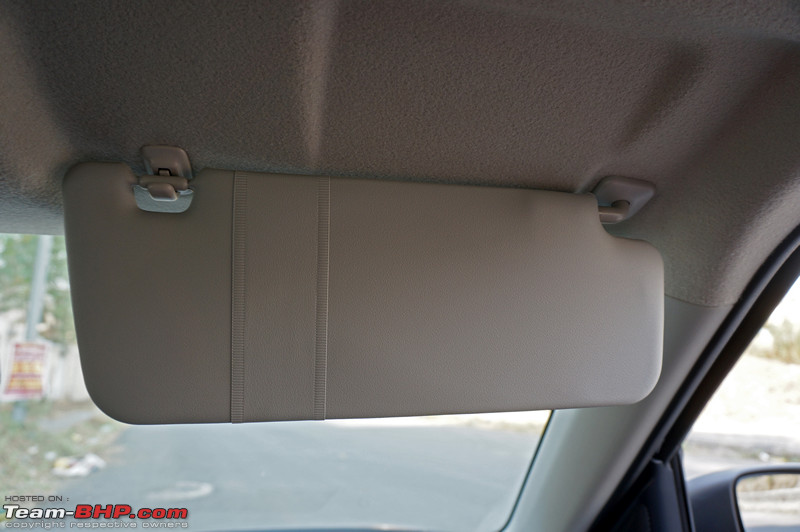 Passenger-side sunvisor gets a vanity mirror, but there's no cover or light provided. Awfully cheap on a car whose top variants now cost almost 10 lakhs on the road: 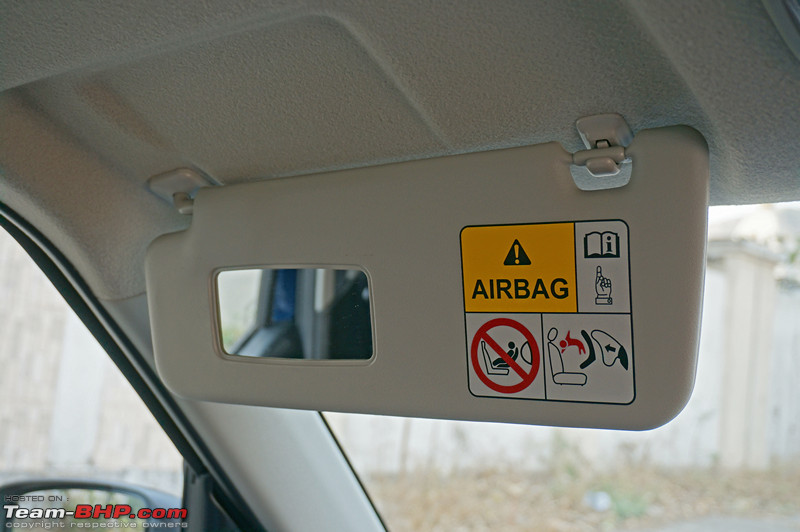 Last edited by GTO : 19th April 2018 at 11:40. |
| |  (41)
Thanks (41)
Thanks
 |
| The following 41 BHPians Thank Aditya for this useful post: | adneeraj, AltoLXI, AutoIndian, Avikbrio, CarguyNish, carrazy, chiranjitp, dailydriver, darklord, espraveen, Gannu_1, GTO, InControl, lemedico, Leoshashi, libranof1987, MidnightBlack, N33raj, Obi-Wan, phoenixash, phynix123, Ponbaarathi, Rambo-RS, Reinhard, Researcher, romeomidhun, samabhi, Sheel, shreyak_ss, Simhi, strawhat, suhaas307, sukiwa, swiftnfurious, theexperthand, uday.ere, vaasu, Varun_HexaGuy, vb-saan, VeluM, vredesbyrd |
| | #5 |
| Team-BHP Support  | Interior - Rear Like the front, the rear doors of the Swift open and close in a triple-stage action (unique, as most cars have a dual-stage action at the rear). We felt they didn't open sufficiently wide, and the roof of the car is low too. The roof slopes downwards at the rear and the rear seat is also placed lower than we would like, which means you have to 'sit down' in the car. This makes ingress & egress inconvenient for taller people, although average-sized users should not have a problem. If you are upgrading from a WagonR, you are in for a shock:  Wide gap between the B-Pillar and the bench makes it easier to step in & out:  Door sill isn't excessively wide either, which means occupants do not have to carry their feet over the sill when entering or exiting the car. No scuff plates have been provided:  Like the front, the rear doorpads get a black colour theme. The silver inserts, padding and fabric inserts (seen at the front) are all missing here. Because of that, the door looks bare or as if it's from a base variant:  Bottle holders are smaller than the ones at the front and can hold only 500 ml bottles. There are no door pockets:  Rear legroom has improved over the outgoing Swift. While Maruti claims that rear shoulder room has increased by 8 mm, only 2 adults and a kid at the most will be able to sit comfortably. A 3rd adult should be no more than an occasional visitor. No comparison with the Baleno which is noticeably more spacious. The seat base is largely flat with no prominent contours. No center armrest provided:  Rear seat is wider than the outgoing car's. Still, it's not a hatchback in which you can have 3 healthy adults on the back seat. The seatbase is slightly raised in the middle where the third passenger sits. This means he has lesser headroom than the side occupants. Since there is no armrest, the 3rd passenger has a better backrest:  Rear seat gets hooks to park the seatbelts:  Middle passenger gets a lap belt. Seatbelt buckles are housed in dedicated cutouts in the rear seat. They can be pushed completely in:  With the 20 mm increase in wheelbase length, Maruti claims to have added more legroom at the rear. Moralfibre confirms that legroom has increased compared to the old car (which he owns):  A look at the maximum and minimum legroom:  Sufficient legroom. With the front seat in my driving position (5'10"), I have about 3 inches of knee room to spare. With the front seat in the full forward position, the knee room is around 10 inches. If they are moved all the way back, my knees touch the seatback. However, it is soft and scooped out, so it does not hurt. Additionally, there is adequate space below the front seats which enables you to slide your feet under them:  The seatbacks are scooped out, which helps in freeing up some more knee room:  Rear bench has sufficient cushioning, but is set low. This means that you sit down in it. At 5'10", I found the under-thigh support to be average - medium-sized folk will be fine, but taller occupants will find it lacking. Maruti claims that headroom has increased by 24 mm - it was adequate for me. The seat's cushioning is rather soft; passengers will like it within the city, but it'll offer lesser support on highway journeys:  The headrests have just two positions of adjustment - all the way up or all the way down (nothing in between):  Large front headrests severely obstruct the frontal visibility of rear passengers. They look so damn weird too!  ISOFIX child seat anchors have been provided on both sides. This is a standard feature in all variants of the Swift  : : View out of the rear window. Black panel restricts visibility as that's exactly where the rear passenger's head is. Not cool:  Rear window can be rolled down all the way...well, almost:  Seatback pocket only on the left seat. It is not deep, yet adequately wide:  Spring-loaded grab handles above each passenger door have a damped action. No bag / coat hooks though:  C-Pillar is very thick. It is short in height - an indicator of how much the roof slopes down towards the rear:  No air-con vents or charging points for smartphones here, just this bottle holder located at the end of the center console:  Floor hump is about 3 inches high and not very wide. Still, this along with the cupholder on the center console means the middle passenger will prefer to put his feet on either side of the hump:  Roof liner is whitish-grey in colour. No cabin light for rear seat occupants. Compare the front of the cabin with the rear and it's obvious all the money has been spent at the front only:  Boot's mouth is wide, but loading lip is high. The hatch can be unlocked by using the central unlocking button on the driver's door, pressing the unlock button on the keyfob or using the button on the hatch. It can be opened only via the electromagnetic release. 268 liters of boot space marks an increase of 64 liters over the outgoing car. It is also larger than most of the cars in the B2 segment now (Baleno & Jazz are in a different league though). Excellent packaging skills - in a car that's shorter, Suzuki has increased rear legroom as well as boot space!  Parcel tray has a prominent recessed area + border to prevent things from rolling off:  For increasing luggage space, the rear seats can be folded down. Pull this knob up to unlock the seatback and fold it (there's one more knob on the other side):  Rear seat splits in a 60:40 ratio which allows selective folding if you need to carry a combination of cargo + passengers. However, the seatbase cannot be tumbled forward:  Folding the seatbacks gives you cargo capacity of 579 liters. It's not at all a flat floor though:  One baggage hook and the boot light are on the left:  Boot light has a switch to turn it on or off. Can't really think of anyone who'd want to switch the light off, except at times when the boot is left open for hours together (while cleaning or at picnics?):  Jack is stowed away neatly in a compartment on the right:  Top tether for the child seat (there are two of them):  Tailgate gets full black plastic cladding on the inside. No cost-cutting here. Slots have been provided on both sides to pull the tailgate down (good for lefties):  Yuck! Maruti has done a fair job of concealing most of the wiring. However, some ugly bits like this demister connector stick out like a sore thumb. There's one on the other side as well. A plastic cap should have been deployed to cover them:  Cutout to slide your fingers in and lift the spare wheel cover:  Spare wheel is a 14-inch steel unit with a 165/80 section tyre and a speed limit of 80 km/h. Maruti should've given a full-size spare to the top variant. Since the spare is the same size as the standard wheels of the lower variants, this 80 km/h speed limit doesn't apply to the L & V trims:  No Styrofoam casing or a dedicated slot to tuck away the toolkit. Kit consists of the regular tyre-changing tools and a safety triangle. Notice the cloth bag for storing them:  Last edited by GTO : 19th April 2018 at 11:40. |
| |  (27)
Thanks (27)
Thanks
 |
| The following 27 BHPians Thank Aditya for this useful post: | 2himanshu, AltoLXI, CarguyNish, carrazy, chiranjitp, Chrome6Boy, espraveen, GTO, InControl, lemedico, Leoshashi, libranof1987, N33raj, Nimalan, Obi-Wan, phoenixash, Researcher, romeomidhun, S.MJet, Simhi, sukiwa, sumeethaldankar, swiftnfurious, uday.ere, vb-saan, VeluM, vredesbyrd |
| | #6 |
| Team-BHP Support  | In-Car Entertainment The Z+ (top) variants of the Maruti Swift get a SmartPlay touchscreen infotainment system, which offers smartphone connectivity with Android Auto, Apple CarPlay and Mirror Link. Music is played through 6 speakers (including 2 tweeters). Connectivity is through Bluetooth, USB and Aux. A CD player is missing, but then, who uses CDs today. The system also comes with navigation (by 'Here') and voice recognition & serves as a screen for the reversing camera. The now familiar 7-inch touchscreen is very easy to operate, but visibility under direct sunlight is average. While the screen is pretty sensitive to scrolling and clicking, there is a little lag. It is not as quick as scrolling on a smartphone. The home screen is divided into four logical sections. Piano black panels with silver borders look sweet:  In the Z & Z+ variants, music is played out through 6 speakers (including 2 front tweeters). V variants get 4 speakers:  Tweeters placed on the doors create a pretty high sound stage. Feels like the music is coming from the ear level:  Rear speakers are placed on the doors too:  Music can be played from a variety of sources (including SD Card):  The interface is simple and easy to operate. Font size is large as well, making it easy to read on the go:  Sound settings include the usual equaliser settings and fader/balance adjustments. For a car of this segment, the sound quality is satisfactory, especially at low to medium listening volumes. It is only at higher volumes that you notice a distortion in the bass. We also felt the treble was on the higher side. Even at level 3, it sounded excessive. You might want to turn it down by a level or two in the equaliser settings:  A number of presets are also provided:  Touchscreen allows you to change the sensitivity of the speed-dependent volume control...  ...and the brightness of the display:  Other settings that can be altered include the clock...  ...language (Indian English  )... )... ...and unit of measurement (metric or imperial):  Infotainment system can be locked or unlocked via a PIN. This lets you handover the vehicle to a driver without giving him access to the full system:  Navigation is via pre-loaded maps on an SD card:  Pairing with your smartphone is quick & easy. Owners will love the iOS & Android integration:  Every time you touch the center of the touchscreen, a small display to control frequently-accessed functions (e.g. next / previous track) appears on it:  Call clarity is satisfactory:  Like the Ignis and Dzire, the Swift gets Android Auto. To use it, owners have to connect their smartphones to the system via a USB cable:  Get directions, make calls, send and receive messages (including WhatsApp) and listen to music + audio books through a touch interface or voice commands:  Navigation through Google Maps is very easy. Android Auto also helps in getting real-time traffic updates (via Google) on the screen:  Owners of the Z+ variant can download the Suzuki SLDA Remote App on their smartphones, connect it to the infotainment system via Bluetooth and use their phones just like a remote control. Might be useful for chauffeured owners:  You can switch the audio system on or off with the app. You can also select the music source, adjust the volume to your liking and mute/unmute the system:  Parking display is clear with colour-coded distance demarcations. However, it does not get adaptive guidelines. That said, the camera along with the reverse parking sensors helps greatly while backing up:  One can alter the brightness & contrast levels of the parking display:  Reversing camera is effective at night as well:  Z & V variants get a basic 2-DIN music system with Aux-in, USB and Bluetooth connectivity:  Z & V variants get a remote control for the audio system:  Last edited by GTO : 19th April 2018 at 11:39. |
| |  (26)
Thanks (26)
Thanks
 |
| The following 26 BHPians Thank Aditya for this useful post: | AltoLXI, CarguyNish, carrazy, dailydriver, espraveen, Gannu_1, GTO, InControl, lemedico, Leoshashi, libranof1987, N33raj, Nimalan, Obi-Wan, phoenixash, Researcher, romeomidhun, S.MJet, Sheel, sukiwa, swiftnfurious, uday.ere, Varun_HexaGuy, vb-saan, VeluM, VTec_KickedInYo |
| | #7 |
| Team-BHP Support  | Driving the 1.2L Petrol MT Familiar 1.2L K12 engine found in many other Maruti cars. Even with a small engine bay, empty spaces are visible. Notice that the petrol doesn't get an engine cover; looks ugly without it:  The Swift petrol is powered by the same 1,197cc, 4-cylinder K12 petrol engine with variable valve timing tech (VVT) that did duty in the outgoing car. This engine is also found in other Maruti products such as the Dzire, Baleno and Ignis. Like the Dzire, this mill produces 82 BHP @ 6,000 rpm and 113 Nm of torque @ 4,200 rpm, which is 1 BHP lesser than the Baleno and old Swift. The torque produced is also lesser by 2 Nm and delivered 200 rpm higher. With a kerb weight of merely 855-880 kilos, the Swift is among the lightest cars in its class. Only the Ignis is lighter. It has a power-to-weight ratio of 96 BHP / ton and a torque-to-weight ratio of 132 Nm / ton. Both these figures overshadow most other B2 segment cars such as the Hyundai Grand i10 and Ford Figo 1.2. Due to the lower kerb weight, the power-to-weight and torque-to-weight ratios of the new Swift are 10 BHP / ton and 13 Nm / ton higher than the old car's, and just 3 BHP / ton and 5 Nm / ton short of the Ignis'. Guess this gave Maruti the chance to detune the engine slightly to enhance fuel economy. To start the Swift, you need to press the clutch and then hit the engine start / stop button. The engine's refinement levels at idle are very good. The 1.2L K-series has been around since nine years now, but it’s still a jewel of a motor and feels 'more with the times' than the 1.3L diesel. With the lighter weight of the new Swift, the engine feels more sprightly, while throttle response is very crisp. The Swift moves off from a standstill easily and offers good driveability in the city. The engine's low rpm behaviour will satisfy most drivers and you can potter around town in 4th gear at 40 km/h with the motor ticking over at ~ 1,250 rpm without feeling lugged. There is adequate power on offer & you won't be downshifting excessively either. Keeping up with city traffic is no trouble for the 1.2L petrol. The availability of power from low revs along with the refinement on offer made Moralfibre (who has been driving a Swift diesel for the past 7 years) fall in love with the petrol. The car's low-speed behaviour coupled with the compact size, light controls, good frontal visibility and sorted ergonomics make the Swift a very good car for urban commuting. Take the Swift out on the open road and one can really enjoy the performance that the 1.2L unit offers. Power delivery is linear in nature and the rev-happy engine is refined throughout the rpm range. While there is enough power available lower down, the engine really starts feeling responsive above 2,500 rpm and accelerates strongly all the way to its redline. Along with the spirited performance, the 1.2L engine sounds sweet, and enthusiasts will enjoy high-revving it. The only downside is that Maruti has set the max engine rpm to a rather conservative 6,300 rpm. You get the feeling that the engine has a few hundred revs left in reserve when you (unexpectedly) hit the rpm limiter in the middle of an overtaking maneuver. This will force you to upshift, losing time in the process. The Swift can cruise on the highway at 100 km/h and 120 km/h with the engine turning over at 2,500 rpm and 3,000 rpm respectively. At these rpms, the engine feels comfortable and not stressed in any way. While there is sufficient power throughout the rev range, it’s best to shift down a gear or two while overtaking on single lane highways to keep the Swift in the meat of its power band. The clutch is very light and easy to operate. Its travel range is neither too long nor too short. The 5-speed manual gearbox is smooth to use, with well-defined gates and short throws. It’s precise, so you will never miss a gear or slot into the wrong one. The gearshift quality along with the rev-happy petrol makes this combination a great choice for driving. With its light kerb weight, the new Swift petrol has an ARAI figure of 22.0 km/l, making it 8% more frugal than the old car (20.4 km/l). This figure is identical to the Dzire's and makes it the most fuel-efficient petrol car in its segment, narrowly beating the Baleno's figure of 21.6 km/l. Coming to NVH levels, the Swift does very well at slow speeds and around town. The engine is barely audible at city speeds. But when you climb up the revs, you realise that the quality of the insulation materials could have been better. At high rpm, the engine is audible inside the cabin. While the noise is not excessive and might actually appeal to enthusiasts, regular folk are unlikely to enjoy it over long periods. At speeds above 80 km/h, there was some wind noise heard around the B-Pillars, and road noise starts creeping into the cabin above 100 km/h. These get louder as the speed increases. Free-revving petrol engine produces 82 BHP and 113 Nm of torque:  Both - the petrol and diesel - get an insulation sheet under the bonnet. See the black plastic panel on the top of the bonnet (above the locking hook)? It corresponds with the plastic sitting on the cross member. Might be some kind of protection from weather / water:  The firewall insulation. While it is sufficient in the petrol, it isn't enough for the diesel:  No underbody protection. You can see the ground below clearly:  Hanging ECU is bolted on to the firewall on the left side of the engine bay:  Air-intake snakes all the way to the front of the engine bay for cooler air:  Driving the 1.2L Petrol AMT Apart from the 5-speed manual transmission, the 1.2L petrol engine is available with a 5-speed automated manual transmission, which Maruti calls 'Auto Gear Shift' (AGS). The 5-speed AMT unit is sourced from Magneti Marelli and is being offered on the VXi and ZXi variants only, which is unfortunate since the Dzire gets this transmission in the ZXi+ trim as well. While this is not the first time Maruti has used this engine - transmission combination, it is the first time it is employed in the Swift. The old car did not get any automatic option. The AMT mechanism is a simple bolt-on job and it uses the Swift MT's existing gearbox. Mechanically, the AMT gearbox is identical to the Swift’s manual transmission. What's different is how the clutch is operated and how the gears are shifted. In the manual, the driver is responsible for these tasks. With the AMT, hydraulic actuators located in the engine bay operate the clutch and shift gears. There's no clutch pedal, and zero driver input is required for gearshifts, making it exactly like a conventional automatic to drive. Simply put, the mechanical functions of operating the clutch and gear lever have moved from inside the cabin to the engine bay. To know more about AMTs & how they work, click here. AMTs, as we know, are cheaper to build than proper automatic gearboxes (torque converters, dual clutches). However, Maruti has priced the Swift petrol AMT at Rs. 6.34 lakhs (VXi) and Rs. 6.96 lakhs (ZXi), which is not as expensive as the Baleno CVT, but approximately Rs. 52,000 - Rs. 74,000 costlier than the equivalent variants of the Ignis with the same engine & gearbox combination. In fact, the Swift AMT is slightly more expensive than the Hyundai Grand i10 which has a 4-speed torque converter gearbox!! Compared to the MT, the AMT carries a premium of Rs. 47,000 across all trim levels. The AMT has the standard N, R, D and M positions. There is no 'P' (park) mode or gear unlock button like in a conventional AT. To start the car, the gear shifter has to be in N (neutral) position and the driver's foot has to be on the brake pedal. The Swift AMT has no problem rolling off from a standstill. Throttle response when starting off is good. The AMT functions like a regular automatic gearbox and, as the driver doesn't need to press a clutch pedal or shift gears, it results in a stress-free drive. Additionally, putting the car in D / M mode and releasing the brake pedal will result in the Swift creeping forward without any accelerator input. In bumper to bumper traffic, you can drive the Swift with just one pedal (i.e. the brake). Without any throttle input, the car will keep moving at ~7 km/h. In general, keeping up with urban traffic is easy. However, the gearbox suffers from slow gearshifts (particularly during upshifting) and there is a delay of a second or so from the time one gear is disengaged and the next one is engaged. This results in a jerk and as we've noticed in other AMTs - the lull in acceleration makes your head bob forward. If the car is being driven in a relaxed manner, things are smoother (although you will still notice each gearshift). The gearbox's operation is silent too. It's only when the driver gets aggressive with the throttle that things get jerkier, resulting in your head swaying back & forth. This can be a deal breaker for some (including GTO) and if refinement is a priority for you, just opt for the Grand i10 AT / Baleno CVT instead. That said, Maruti is definitely improving the smoothness of the AMT with each new car launch; however, there is no comparison with a conventional AT in terms of refinement. It is important to note that while every upshift from 1st to 3rd gears is felt, the shifting between 4th and 5th is smoother. There is a way of reducing these jerks. When accelerating up to speed, let off the accelerator at specific intervals (just as you would while upshifting in an MT). The AMT will seize that opportunity to upshift. With a light foot, higher gears are engaged at ~2,000 rpm. Overall, the larger K12 engine is a better combination with the AMT vs the AMT + K10 in the Celerio and Alto. The larger motor masks the shortfalls of the AMT to a fair extent. The AMT and K10 engine combination is jerkier and because the smaller engine is down on power, the gearbox has more work to do. On the open road, the AMT is much more at ease with a relaxed driving style than an aggressive one. It works well for a driver who prefers to build up speed gradually. The engine has enough grunt to keep the Swift running at triple digit speeds all day long and with a light foot, the transmission is also smoother. Driving in D mode is good on the highway as long as you are happy to cruise. Speaking of which, she cruises at 100 km/h in 5th gear at ~2,700 rpm. Put your foot hard down and the engine revs to 5,800 rpm before the transmission shifts up. What is noticeable is the way the revs jump up when the driver slams the throttle to match the revs in the lower gear while the transmission eagerly shifts down. The shift, however, is nowhere close to being as quick as a DSG. That said, the response time is not as slow as some other cars with AMTs. It is quite acceptable for expressway driving. Even then, it's best to use the manual mode while overtaking on undivided highways. The AMT comes equipped with 'Manual mode' that can be engaged by moving the gear shifter to D, and then to the left. Pull the shifter down to upshift and push it up to downshift. In M mode, the transmission does not upshift on its own. Driven hard, the engine will rev to 6,250 rpm. It will not allow you to upshift if it finds the revs too low or downshift if the resultant revvs are too high. M mode comes in handy when one wants to overtake quickly. While the response time is far from instant, it's still a bit faster than D mode. M mode is useful to bring the engine into its powerband before an overtaking maneuver & also during the actual overtaking (to prevent the AMT from an unintentional + slow upshift while you're overtaking). Another time when the M mode can be used is when you desire engine braking. Driving downhill, this mode aids engine braking which in turn, reduces the workload on the brakes. It must be mentioned that there is a slight delay between the time you tap the gear lever and the gearshift actually happening, resulting in a jerk. Therefore, even in this mode, it is advisable to let go off the throttle for an instant while upshifting, just like you would do in the case of a conventional manual transmission. Coming to fuel consumption, the AMT's claimed FE figure is identical to the manual's 22.0 km/l. Magneti Marelli-sourced AMT unit sits on top of the gearbox on the left of the engine bay:  AMT shifter is identical to the Dzire's. The only difference is the piano black insert in place of the silver one. It looks good, but shift actions can get jerky. Might be a deal breaker for some:  The gear console is finished in piano black and has a sweet silver border. Like other AMT’s, there’s no "P" mode:  AMT's MID gets a gear indicator. The car cannot be started unless neutral (N) has been engaged. The "D" next to the "1" denotes "automatic" mode, while the "M" denotes "manual" mode. Currently selected gear is shown in both, automatic & manual modes. The transmission allows you to shift up to 2nd gear even when the car is standing still; the car can move from a standstill in 2nd (might be useful when starting off on a super slippery surface):  Last edited by GTO : 19th April 2018 at 11:38. |
| |  (25)
Thanks (25)
Thanks
 |
| The following 25 BHPians Thank Aditya for this useful post: | 2himanshu, akshay81, AltoLXI, CarguyNish, carrazy, chiranjitp, Flyer, Gannu_1, GTO, Leoshashi, libranof1987, N33raj, Nimalan, Researcher, romeomidhun, S.MJet, Simhi, sukiwa, swiftnfurious, uday.ere, Varun_HexaGuy, vb-saan, VeluM, vredesbyrd, VTec_KickedInYo |
| | #8 |
| Team-BHP Support  | Driving the 1.3L Diesel MT Fiat-sourced 1.3L DDiS engine needs no introduction; shared with several cars from Maruti and other manufacturers:  The Swift diesel is powered by the same 1,248cc, 4-cylinder diesel engine found in many cars from the Fiat, Maruti and Tata stables. Maruti calls this unit the DDiS 190. It features a fixed geometry turbocharger and develops 74 BHP @ 4,000 rpm with peak torque of 190 Nm @ 2,000 rpm (identical to its siblings). Once again, it's the new Swift's lower kerb weight of 955-985 kilos that gives it better power-to-weight (77 BHP / ton) and torque-to-weight (199 Nm / ton) ratios than its predecessor (70 BHP & 179 Nm). Still, the Swift diesel has an average power-to-weight ratio in the B2 segment. Cars like the Ford Figo, Honda Jazz and VW Polo manage to easily better its figures since they have more powerful 1.5L engines. Where the Swift petrol was impressive, the Swift diesel is just 'adequate'. That's a good way to summarise its on-road performance too. Like the petrol Swift, you have to press the clutch and hit the engine start button to fire up the engine. On startup, there is a slight shake and mild vibrations are felt on the steering wheel. While the familiar clatter of the diesel is still audible inside, it is quieter than the outgoing car. Off the line, the car moves off without any effort. There is a little turbo lag, but even at low rpms, it’s not dead. In fact, you can get moving from a standstill in second gear without stalling. Maruti has done a good job of tuning the engine for the city. In most conditions, there is enough torque available and you don't need to downshift too often. Things change when you need to close gaps quickly though. Put your foot down and the lag is felt. In such situations, you definitely require a downshift. Here, it simply doesn’t have the low speed torque of the Figo or Jazz. The Swift's engine starts coming into its stride from 1,500 rpm and you feel the turbo kicking in once you cross 2,000 rpm. On the open road, the Swift diesel is no slouch, but neither can we say it's exciting. With the speedometer reading 100 km/h in 5th gear, the old Swift's engine used to be spinning at ~2,300 rpm, with the turbo boiling. Upon slamming the accelerator down, it would just take off. In the new car, the turbo kick is not as strong. With every generation of the Swift, Maruti has tuned the turbo for more linear power delivery. You won’t really like to rev the engine hard till the redline. While the engine revvs till 5,200 rpm, all the action is concentrated in the mid-range between 2,000 and 4,000 rpm. Beyond 4,000 rpm, power starts tapering off and at high rpms, the engine makes you feel aware that it’s strained. Additionally, beyond 3,000 rpm, the noise from the diesel engine starts getting loud which can be tiring on longer journeys. The car is at its best if you build speed gradually and cruise on the highway. Chill & enjoy the tall fuel economy figures, we say! In 5th gear, when doing 100 km/h and 120 km/h, the engine is ticking over at ~2,150 rpm and 2,650 rpm respectively. On the expressway, you will not find the need to downshift while overtaking. It's only when you are on an undivided highway and the speed and rpms drop considerably, that you will downshift to pass the vehicle ahead. In general, you always get the feeling that the 1.3L oil-burner has adequate power and torque to keep the average Joe happy, yet enthusiastic drivers are likely to look elsewhere (read = Figo & Polo GT TDI). The clutch is light with an average travel range and isn't likely to tire anyone. Like all other cars that use this engine, the Swift Diesel MT gets a 5-speed manual gearbox. This unit is light to operate, with short throws and well-defined gates. Coming to NVH levels, the diesel clatter and engine noise filtering into the cabin are lesser than the old Swift, but certainly more than what you'd expect by year 2018 standards. Besides, the 1.3L powerplant is now feeling old. As I have mentioned earlier, above 3,000 rpm, the engine noise is loud and beyond 4,000 rpm, it starts sounding and feeling rough. When driving at higher rpms, you will notice some vibrations on the steering wheel & pedals, accompanied by a buzz on the gear lever. Vibrations are also felt inside the cabin when you turn off the engine. Like the petrol, wind and road noise start creeping into the cabin beyond 80 km/h. That said, the overall insulation is slightly better than the outgoing car's. Due to the lesser weight of the new car, the engine does not have to work as hard as earlier, which means it has a higher fuel efficiency rating. The Swift diesel can return 28.40 km/l, which makes it the most efficient car in the country! This is a good thing, because Maruti has given the Swift a tiny 37L fuel tank - 5L smaller than the old car. Diesel fills up the engine bay more than the petrol. It’s also beginning to show its age now compared to the more modern competition. Maruti's new 1.5L diesel couldn't be coming any sooner:  Diesel gets an engine cover, unlike the petrol. It features a fixed geometry turbocharger and develops 74 BHP and 190 Nm of torque:  No underbody protection for the diesel either:  Turbocharger is located in front of the engine:  Fuse box sits to the extreme left of the car in the engine bay, next to the battery:  Underside of the cover contains a diagram of the fuse box, extra fuses and a tweezer:  VIN is etched on the right side of the engine bay:  Subtle gearshift indicator in the MT suggests when to shift up or down. Newbies will appreciate this:  Driving the 1.3L Diesel AMT Like the petrol, the diesel variant of the Swift is also available with a Magneti Marelli-sourced 5-speed automated manual transmission (AMT). AMT hardware is placed at the same location as the petrol variant:  The AMT transmission is available on the VDi and ZDi variants of the Swift diesel. Priced at Rs. 7.34 lakhs and Rs. 7.96 lakhs respectively, the Swift diesel AMT also commands a premium of Rs. ~47,000 over the MT. It must be recollected that the Ignis with the same engine and gearbox is priced between Rs. 6.87 lakhs and Rs. 7.34 lakhs for the equivalent variants. Besides, the Ignis also comes in a top of the line Alpha variant, priced at Rs. 8.12 lakhs with all the bells and whistles that the Swift lacks. We find it strange that, except for the Swift & Ignis, there is no diesel AT hatchback in the market. The working and behaviour of the AMT are absolutely identical to the one in the Swift petrol, as explained in the previous post. Starting the car requires you to put it in N, pressing the brake and hitting the starter button. On startup, there is a slight vibration felt on the gear shifter as well as some cabin shake. Moving off from a standstill is not a problem for the diesel AMT. However, it is not quite as instant as the petrol. The throttle response is duller as well. As we have seen earlier, the AMT functions just like a regular automatic gearbox, and the driver doesn't need to press a clutch pedal or shift gears manually. Again, engaging D / M mode and releasing the brake pedal will see the car creep forward without accelerator input - very useful in stop & go traffic. Without any throttle input, the Swift diesel AMT will keep crawling at ~8 km/h. This creep function works in reverse gear as well. In urban conditions, keeping up with traffic will not be an issue. However, even with a light foot, the gearbox does not shift up from 1st to 2nd gear before the revs cross 2,000 rpm. As the throttle response is dull, you will feel the need to press the accelerator more than in the petrol to get the car moving. As the engine has some turbo lag & there's no torque-converter AT to mask it, all the power feels like it is delivered in a lump. When the traffic in front slows down and you have to release the accelerator, the revs drop quickly and the jerk felt is very annoying. This makes the experience even more unpleasant as you have to deal with the AMT's jerks during shifts as well as when you release the throttle. The AMT also has some weirdness. Say, you take your foot off the accelerator just as the turbo has spooled, the car will still accelerate for a second (thanks to the turbo's boost). This takes some getting used to. There is no such issue with the petrol AMT. It is best to drive the car in a sedate manner because aggressive driving only makes matters worse. The back and forth motion caused by the jerkiness of the AMT along with the dull throttle response and turbo lag could prove to be quite a deal-breaker for the Swift. Just like the petrol, the jerks can be reduced by lifting off the accelerator at intervals and allowing it to shift up smoothly. Still, there isn't a doubt that the petrol AMT experience was smoother; the diesel is noticeably more jerky. On the highway as well, the AMT is more comfortable with a driver building up speed in a moderate manner. This will enable the car to cruise comfortably with the occupants getting a smoother experience. Like the petrol, on flooring the accelerator, the transmission readily shifts down with the engine blipping the throttle to match the revs. The AMT's downshift response time has improved and is comparable to a conventional AT in many situations. Maruti has clearly worked on it. In fact, the shift times are identical to the petrol version. Keep the accelerator pinned down and the engine revvs to 4,000 rpm before the transmission shifts up. M ('Manual mode') can be engaged by moving the gear shifter to D, and then to the left. Pull the shifter down to upshift and push it up to downshift. On hard acceleration, the engine revvs to the redline and the transmission doesn't shift up. M mode comes in handy when one wants to execute quick overtaking maneuvers on undivided highways. It can also be used during downhill driving, when you can make use of the engine braking (although it's lesser in the diesel than the petrol). Additionally, even while driving uphill, there are times when you get the feeling that the engine holds its revs a bit too long in D. The noise from the diesel engine gets loud and annoying. At such times, I found myself using the M mode to upshift and quieten things down. NVH levels and fuel consumption are identical to the manual variant. On pressing the brake (clutch in the case of the manual), a green light appears on the instrument cluster (denoting the engine start button), after which the start/stop button needs to be pressed to fire her up:  No clutch pedal means more space in the footwell. The automatic has a fairly wide and usable dead pedal. I found its angle to be quite comfortable to rest my foot on:  Last edited by GTO : 19th April 2018 at 11:37. |
| |  (24)
Thanks (24)
Thanks
 |
| The following 24 BHPians Thank Aditya for this useful post: | akshay81, AltoLXI, carrazy, chiranjitp, Gannu_1, GTO, haisaikat, InControl, Leoshashi, libranof1987, N33raj, Nimalan, phoenixash, Researcher, romeomidhun, S.MJet, Sheel, sri2012, sukiwa, swiftnfurious, uday.ere, Varun_HexaGuy, vb-saan, VeluM |
| | #9 |
| Team-BHP Support  | Ride & Handling The Swift comes with the ubiquitous McPherson strut suspension setup at the front and a torsion beam setup at the rear. In terms of the tuning, we can summarise that the Swift is more 'sporty' than the likes of the Baleno or i20. The overall urban ride quality is firm; it's not soft & cushiony. At lower speeds, the ride feels stiff due to the 15" wheels (ride quality was better with the lower variant's 14" wheels which I also drove). Even small bumps on the road are noticeable. The car doesn't manage to glide over bumps like the larger Baleno & you will find yourself slowing down for them. That said, the bumps are not jarring for occupants. It's liveable and definitely not a deal breaker, but if you are looking at a 'cushiony' suspension, choose another car. At highway speeds, most bumps and undulations won't bother you. However, large and sharp bumps make themselves felt (even for backseat passengers). Go fast over these and the ride will suffer. Nope, this isn't a car that will 'flatten' bad roads. The high speed stability of the Swift is good, despite the light kerb weight. It can cruise at 120 km/h all day long without feeling nervous. Of course, it does not have that rock solid feel of the Europeans, but it is by no means nervous. The Swift feels well planted and even slightly rough patches of road do not seem to affect its composure. This is the fun part - in terms of handling, grip levels are good and the car can change direction very easily. The Swift feels sharper than most of its competitors & is especially fun to drive with that rev-happy petrol. Body roll is properly controlled and the overall road manners are competent. It even feels tighter and stiffer than the Baleno with which it shares the platform. Maruti has done a good job of differentiating the two cars in the B2 segment. While the Baleno is more spacious and more suitable for family use, the Swift is a driver's car with tighter handling. Do note that our comments are based on the higher variant's 185 mm tyres, and not the woefully under-tyred 165 mm lower variants. Even with the higher variants, the 185/65 R15 Bridgestone Ecopia tyres are designed more towards mileage than grip. Enthusiasts may want to upgrade to grippier rubber which will further enhance the driving experience. The electric power steering is one-finger light at parking and city speeds. This makes it a very easy car to drive in urban situations, but enthusiasts are likely to find it too dull as it is light and feedback is lesser than we'd like. On the upside, the steering is fairly direct and the car's nose is obedient, turning quickly as you want it to. At high speed too, the EPS is on the lighter side (diesel's steering feels a little firmer than that of the petrol). The Swift has a tight turning radius of 4.8 meters, which makes U-turns a breeze to execute. However, one must remember that the steering's return-to-center action is very weak (a design flaw). This means that the driver will have to actually turn the wheel back straight after a U-turn!! The Swift's unladen ground clearance is rated at 163 mm. That's low compared to other cars in the segment. In fact, it is the lowest in its class!! While we didn't scrape over any bumps, we didn't load the car up with 4 passengers & luggage either. Team-BHP ownership reports will tell the real-world story and we remain apprehensive. However, three owners have commented (including on this thread and in this post) that GC hasn't been an issue, even while crossing Bangalore speed-breakers with passengers onboard. Like the old car, the new Swift comes with disc brakes at the front and drum brakes at the rear. However, in the new car, the braking performance is noticeably better. Under hard braking, the car stops in a straight line, sans any drama. The brake pedal has a short travel range and the brakes start biting early on. On applying more pressure, they do a competent job of stopping the car. ABS + EBD are standard on all variants of the Swift. It is not intrusive and kicks in only on hard braking in emergency situations. We're glad that all variants get the same braking hardware; it might be recollected that the lower variants of the outgoing Swift suffered from pitiful braking ability. Last edited by GTO : 19th April 2018 at 11:36. |
| |  (26)
Thanks (26)
Thanks
 |
| The following 26 BHPians Thank Aditya for this useful post: | AltoLXI, Ashir, chiranjitp, dailydriver, espraveen, Gannu_1, GTO, Hrishi_111, Leoshashi, libranof1987, MaheshY1, N33raj, Nimalan, phoenixash, Researcher, romeomidhun, S.MJet, Sheel, strawhat, sukiwa, swiftdiesel, swiftnfurious, uday.ere, Varun_HexaGuy, vb-saan, VeluM |
| | #10 |
| Team-BHP Support  | Other Points • This is the first Swift that Team-BHP has officially reviewed in the usual way. Reason? When the 1st-gen car came out, Team-BHP was still a baby and not into Official Reviews at all. At the time of the 2nd-gen's release, we weren't able to get a car from Maruti for whatsoever reasons, and hence borrowed a BHPian's ride for our review (read it here). • While driving, you can see the rear haunches in your ORVMs  . Almost like a sports car! . Almost like a sports car!• From the time of its launch in 2005, the Swift has sold over 1.8 million copies. It's consistently been among the 5 best-selling cars in India for over a decade. • Produced at Suzuki's new factory in Gujarat. Maruti manufactured the first and second-gen Swifts at its own Manesar (Haryana) plant. This shift of production comes after 13 years. The concept of Suzuki's factory supplying cars to Maruti had created a furore in the stock market (Google it up). • The Gujarat facility is owned by Suzuki Motor Corporation and has an annual production capacity of 250,000 units. A second plant is under construction, while a third one has been planned. After all the three plants are functional, Suzuki will have an annual production capacity of 750,000 vehicles in Gujarat. • Some Maruti showrooms run as efficiently as their factories! Check out this awesome post by BHPian recshenoy. • Via the MID, you can edit some settings for the behaviour of the locks, lights (including follow-me-home headlamps), sensitivity of the security alarm sensors etc. But the process is painful and you can never memorize it; one always needs the owner's manual handy. In comparison, things are much better in the Ignis due to its more friendly interface. • Maruti claims that 50% of Swift owners are first-time buyers; 43% are under the age of 35 years. Notice how the first car is no longer an Alto, as was traditionally the case in India. We hear of first-time car buyers also jumping straight to the Dzire or Verna / City segments! The Indian car market simply rocks  . . • The first sketches of the Swift were leaked in March 2016, around the same time that its test mules were spotted. The car was finally revealed in Japan in December 2016. • Made its India debut at the 2018 Auto Expo in Greater Noida. Official bookings for the car opened on January 18. Booking amount = Rs. 11,000. Deliveries began last month. • The L & V variants get ABS & Airbags, but - in what is an incredibly silly decision - no rear wiper or defogger. These are very important safety essentials that shouldn't have been skipped like this. • If you're looking at a Petrol AT, the Baleno AT is a no-brainer choice over the Swift. Primary reason = its smooth, seamless CVT. • Why is the Diesel AMT so much more jerkier compared to the Petrol AMT? It's because the diesel has to contend with a turbo-charged motor, whereas the petrol's AMT works with a naturally-aspirated engine offering linear power delivery. • Yep, the doors auto-lock at 15 km/h as you move along. They also auto-unlock when you switch the car off. • Bad decision in giving the touchscreen ICE only on the Z+ variant. We feel even the Z trim should have gotten it. • Standard warranty of 2 years / 40,000 km. Extended warranty for up to 5 years / 100,000 km can be purchased (we always recommend it!). • Service interval of 10,000 km / 1 year. There are two basic inspections at the 1,000 km / 1 month & 5,000 km / 6 months mark. • Exports of the made-in-India Swift commenced on April 10, 2018 (The 2018 next-gen Maruti Swift - Now Launched!). • It cost about Rs. 700 crore to develop the Swift. • Comes with around 98% localization. • Fuel tank of 37L is too small; outgoing car was 42L. This is nothing but a weight saving measure (followed by cost saving). • There have been rumours about Maruti bringing the Swift Sport with a 1.4L BoosterJet petrol under the hood. Now, that would really be something else. • The Petrol MT variant is a truly fun-to-drive budget hatchback. We expect to see a lot of souped-up examples around with loud exhausts, blackened roofs, custom rims etc. • Like the Vitara Brezza, Maruti should have offered contrast-coloured roofs on the Swift. In fact, the red Swift begs for a black roof. • Check out the official range of accessories & pricing in this post as well as this one. Thanks to BHPian Leoshashi for sharing the same! • Despite their high pricing, the Z variants account for almost 30% of the bookings (or so we're told). Disclaimer: Maruti invited Team-BHP for the Swift test-drive. They covered all the travel expenses for this driving event. Last edited by Aditya : 20th April 2018 at 11:28. |
| |  (38)
Thanks (38)
Thanks
 |
| The following 38 BHPians Thank Aditya for this useful post: | 2himanshu, Abhi_abarth, AltoLXI, Ashir, CarguyNish, carrazy, chiranjitp, dailydriver, DrANTO, espraveen, Gannu_1, GTO, haisaikat, heavenlybull, InControl, Keynote, Leoshashi, libranof1987, mh09ad5578, N33raj, Nimalan, Omkar, phoenixash, PrideRed, Rajeevraj, Rambo-RS, Researcher, romeomidhun, S.MJet, samabhi, Sheel, Sip, sukiwa, swiftnfurious, uday.ere, Varun_HexaGuy, vb-saan, VeluM |
| | #11 |
| Team-BHP Support  | The Smaller yet Significant Things Apart from the new Lucent Orange colour of our test car, the Swift is available in 5 other shades - Midnight Blue, Solid Fire Red, Magna Grey, Pearl White & Silky Silver. Here, it is seen in Midnight Blue (looks smashing & reminds us of BMW's Carbon-Black colour)...  ...and the Solid Fire Red shade. Want to see white & grey? Click here. Sadly, black isn't part of the palette and it sucks because the Swift would really look HOT in black. BHPian Blackwasp (who has worked in a car dealership for 1.5 years) says that small car buyers prefer lighter colours. Lots of other hatchbacks too aren't available in black: 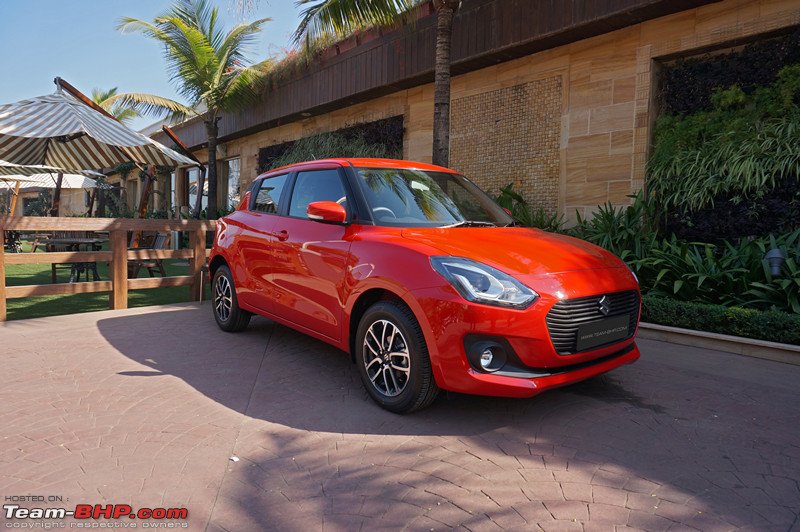 Blue indicator comes on when you start the car in the morning & the engine is cold. When the engine has reached its operating temperature, it disappears. Keep the revs low while this light is on. Also, it will turn red if the motor overheats: 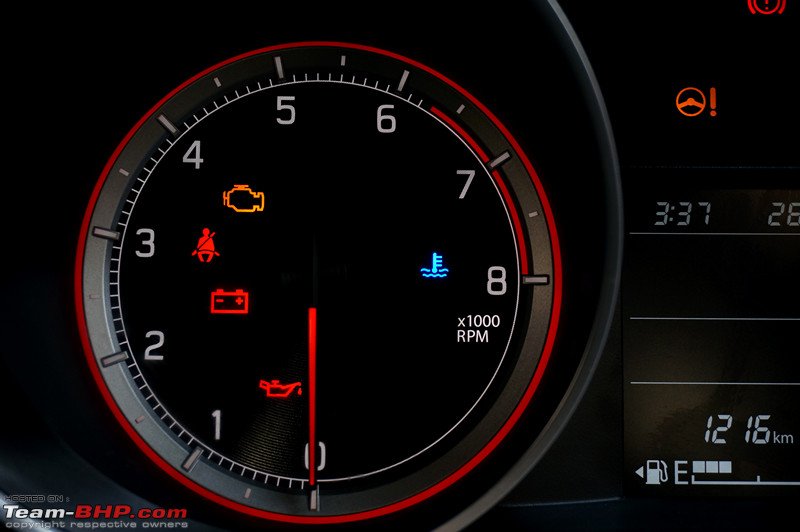 Low fuel warning lamp comes on when the fuel gauge falls to one bar. A single chime sounds when this warning comes on: 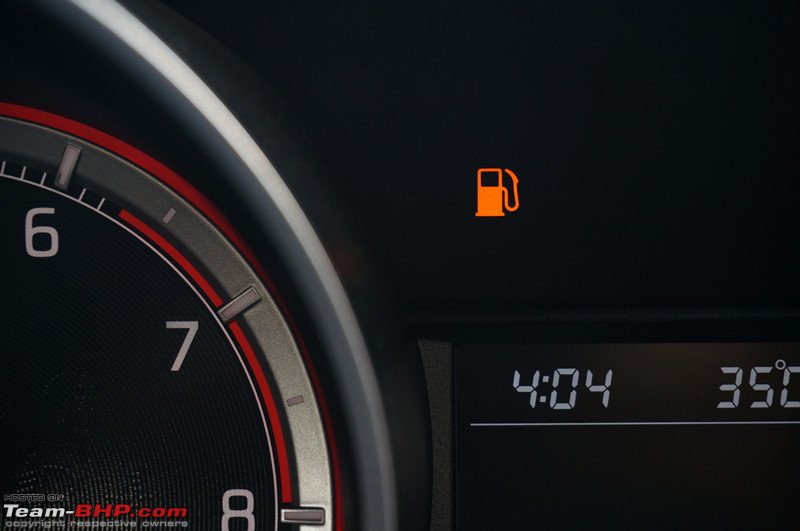 Diesel gets a sticker on the inside of the fuel flap to indicate its dietary preferences. Black plastic spill protector is provided below the fuel cap: 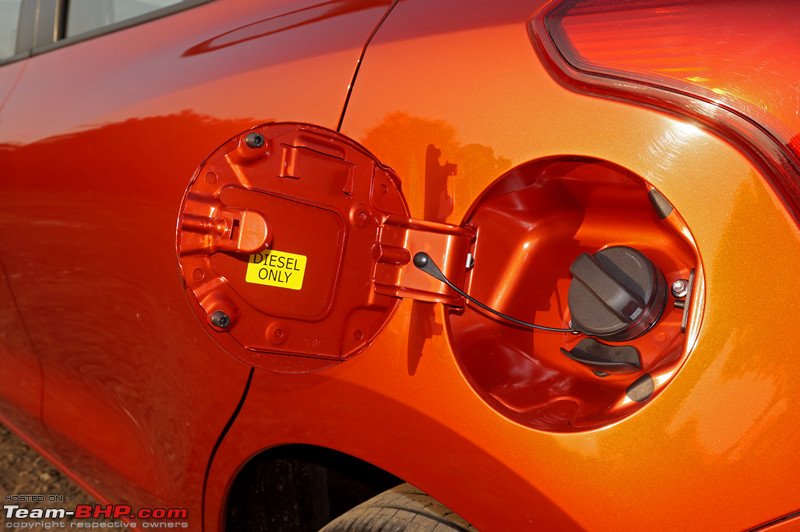 Petrol doesn't get any labelling: 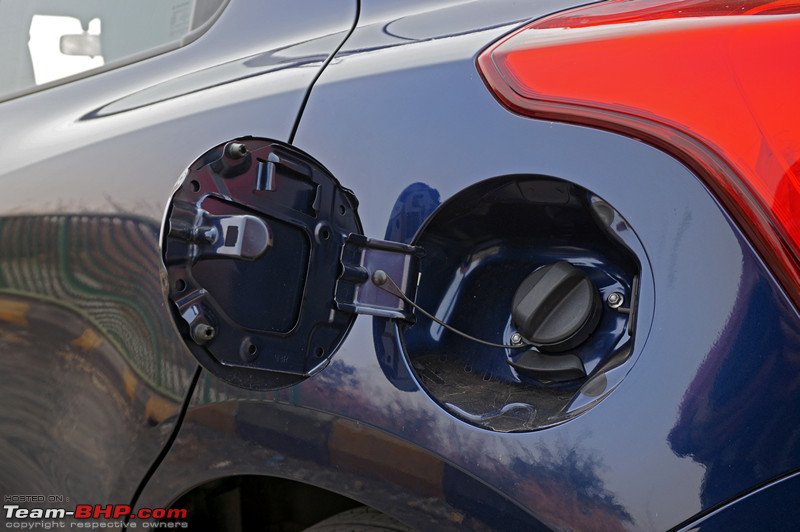 Yes, the ORVMs are India-friendly and will move the other way if a biker side-swipes them: 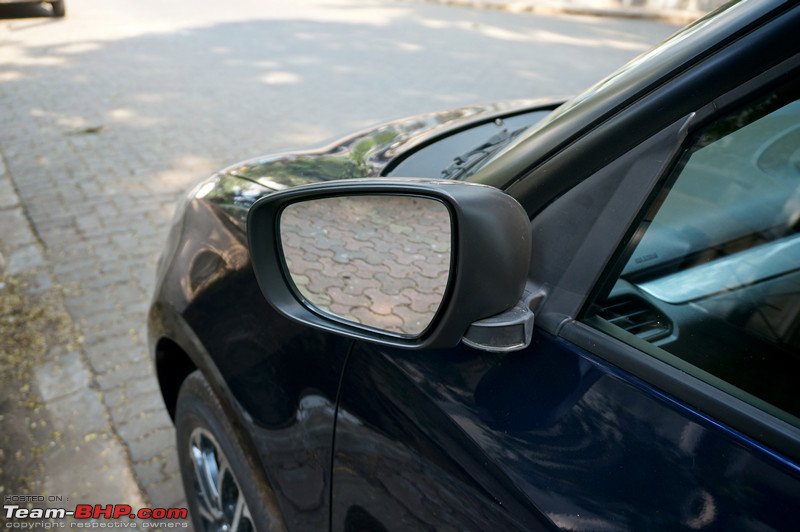 Small 37L fuel tank. Maruti should definitely have given a larger tank. The outgoing Swift had a 42L capacity! 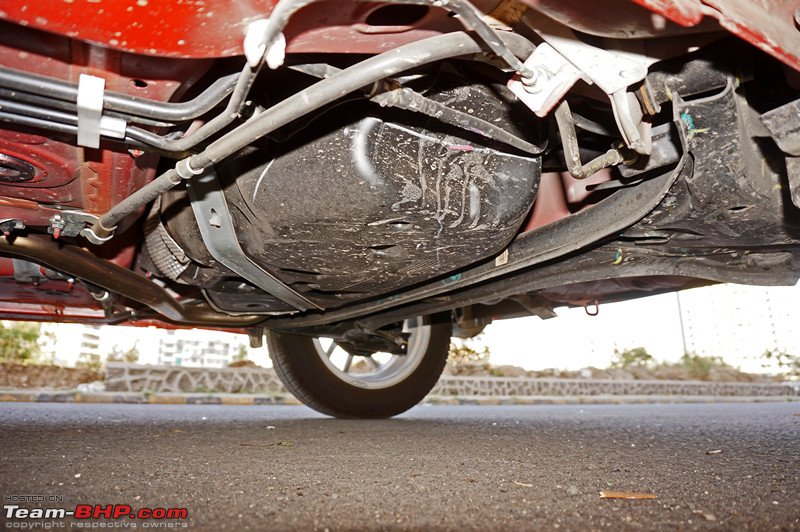 Partial plastic cladding in the front wheel arches... 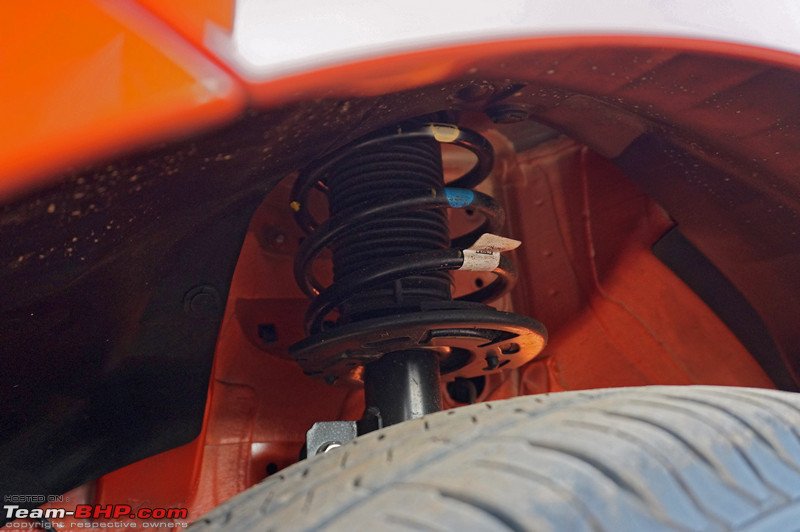 ...while the rear is fuller. Looks like the product guys scored over the bean counters on this generation of the Swift: 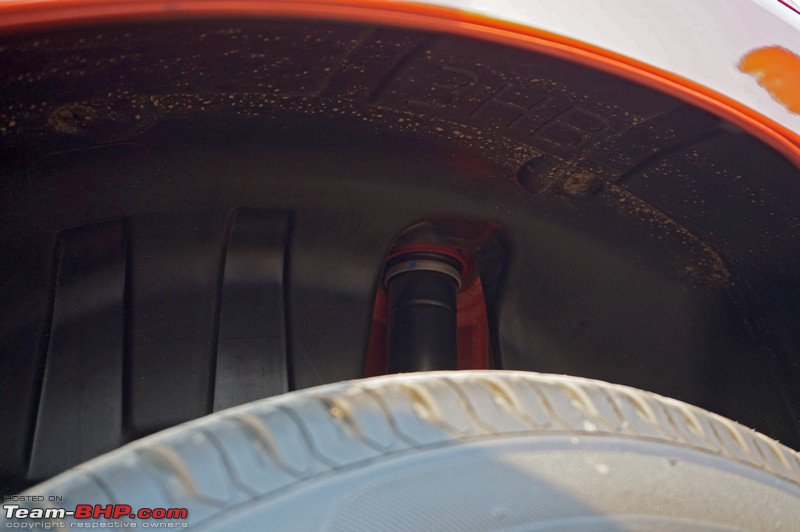 Powerful LED projector headlamps illuminate the road very well: 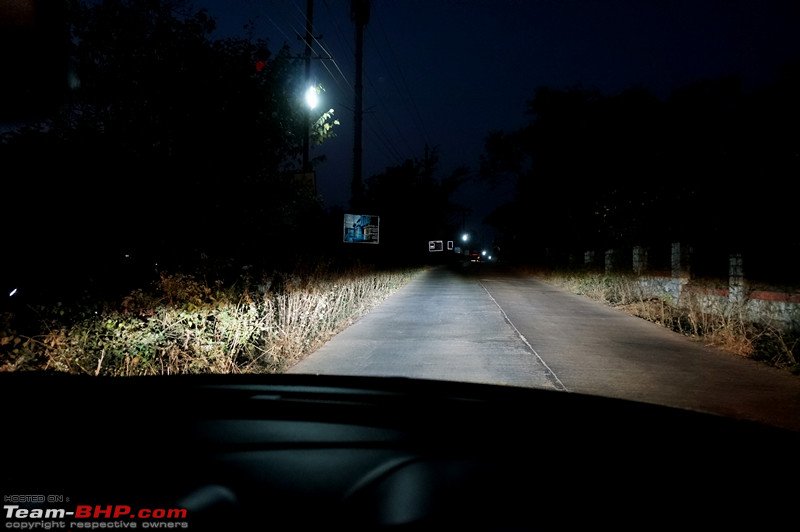 With the high beam engaged, the throw is fantastic! 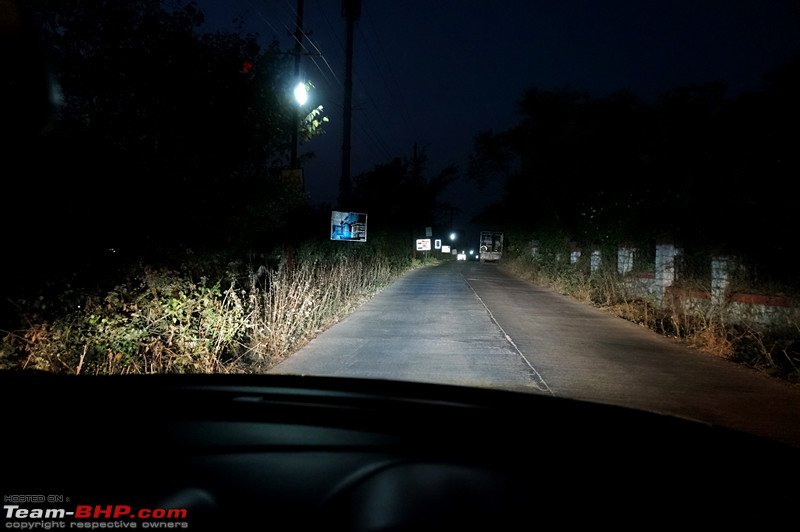 The boring-looking halogen headlamps of the Z and lower variants. No black housing, LEDs or DRLs here: 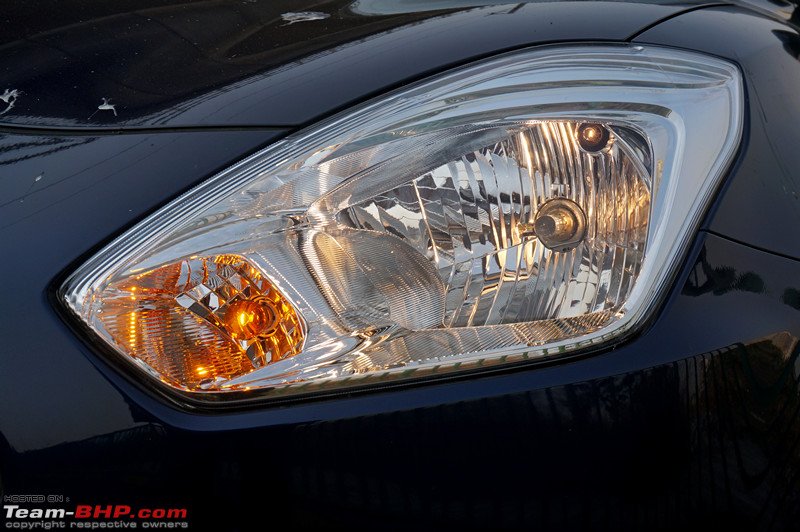 Recommended pressure for both tyre sizes is 32 / 29 PSI: 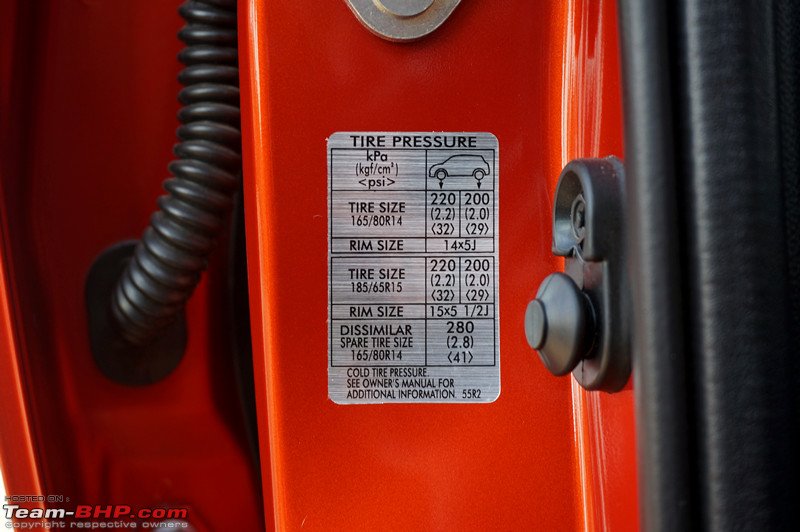 Metal plate with VIN & engine number riveted on the B-Pillar (driver's side): 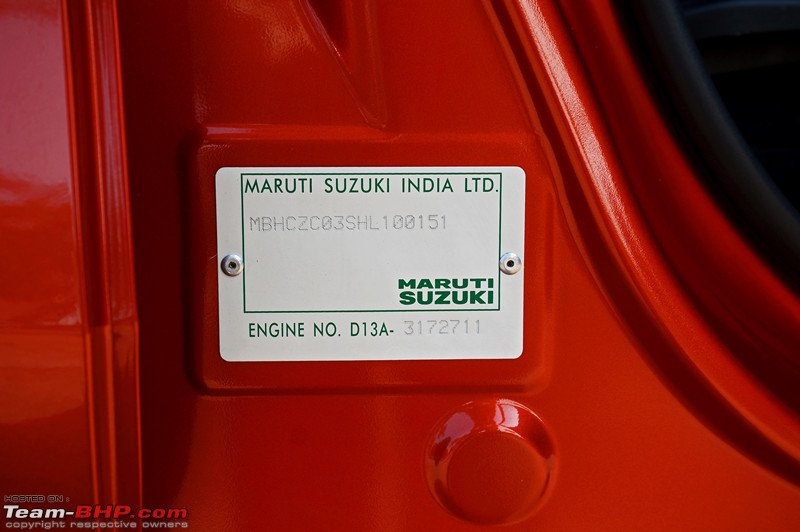 Rubber beading is soft and appears well-fitted: 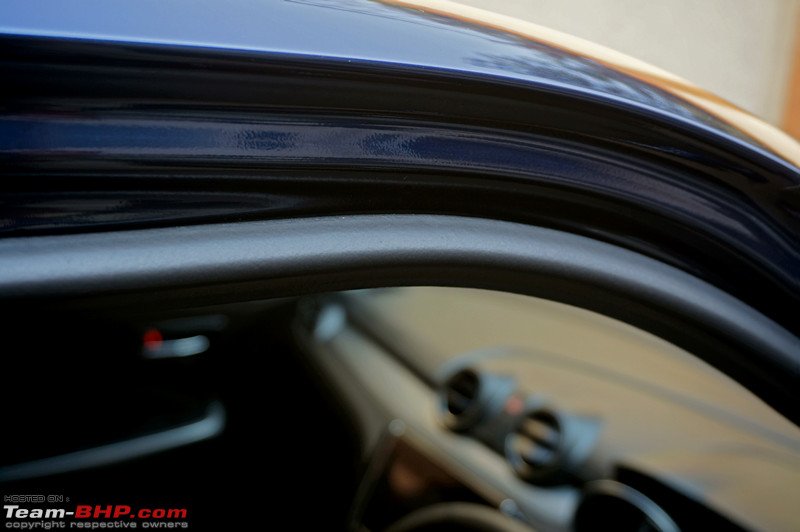 Auto-dimming IRVM is shockingly missing in an otherwise well-equipped car! Why Maruti, why  ? Why go 95% of the way, and leave the balance 5% out? Standard manual adjuster is provided: ? Why go 95% of the way, and leave the balance 5% out? Standard manual adjuster is provided: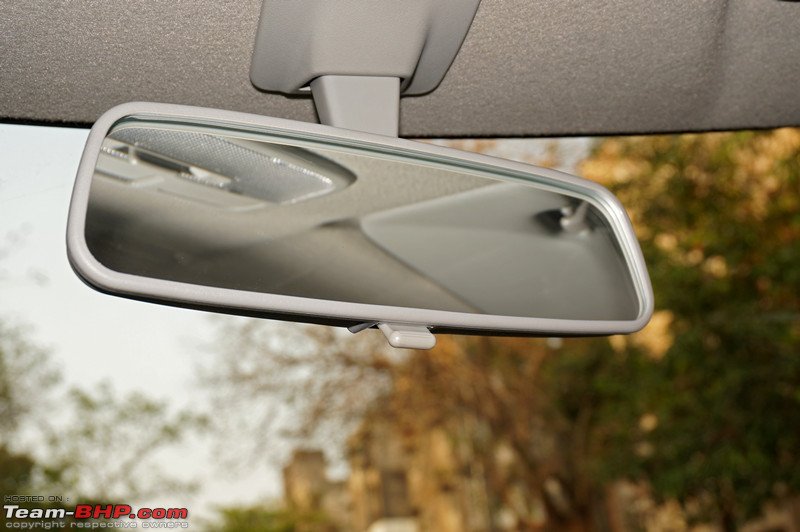 Interior switches including the start/stop button are backlit in orange: 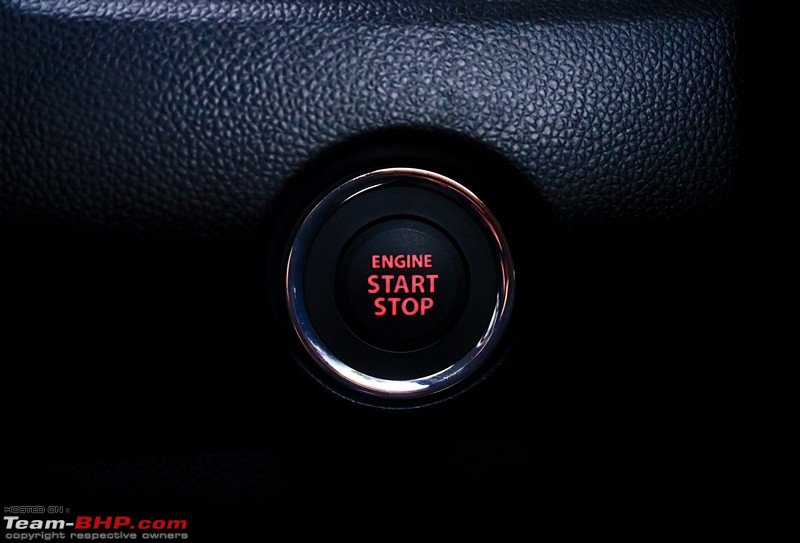 Neatly integrated solar sensor (for the climate control) sits on the right side of the dashboard: 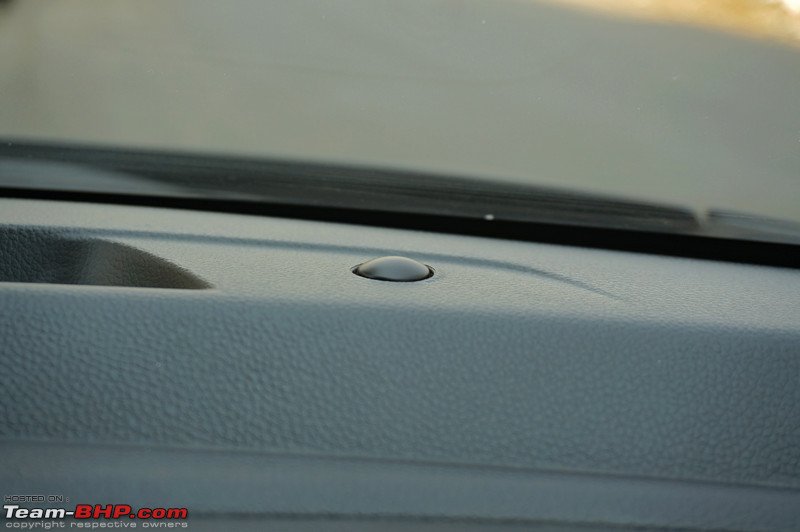 Light sensor (for the auto-headlamps) is located on the left: 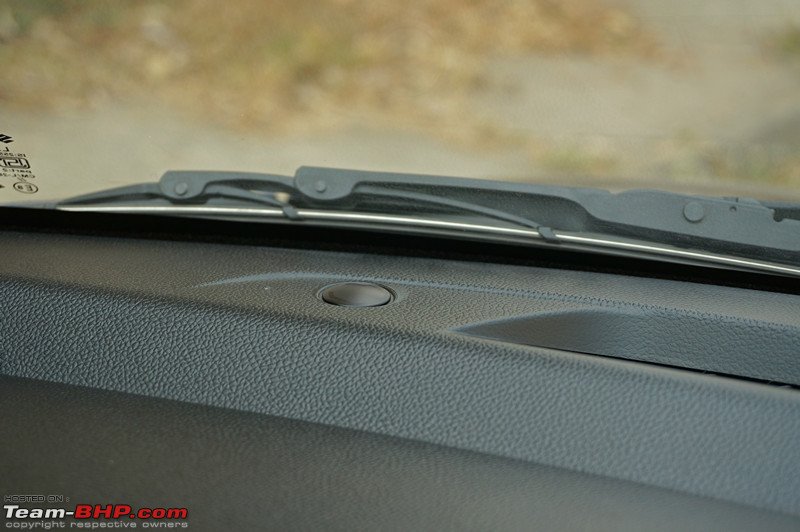 Z and lower variants don't get automatic headlamps and therefore, have an ugly plastic filler in place of the light sensor: 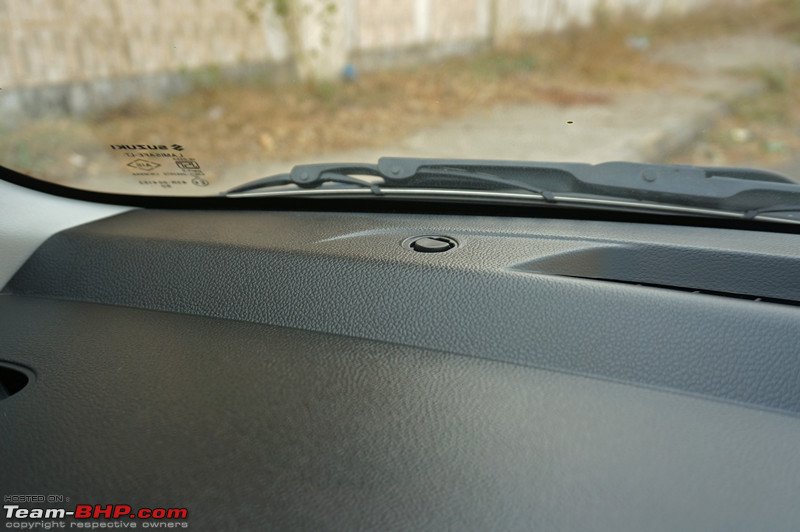 A look at the light stalk of the lower variants: 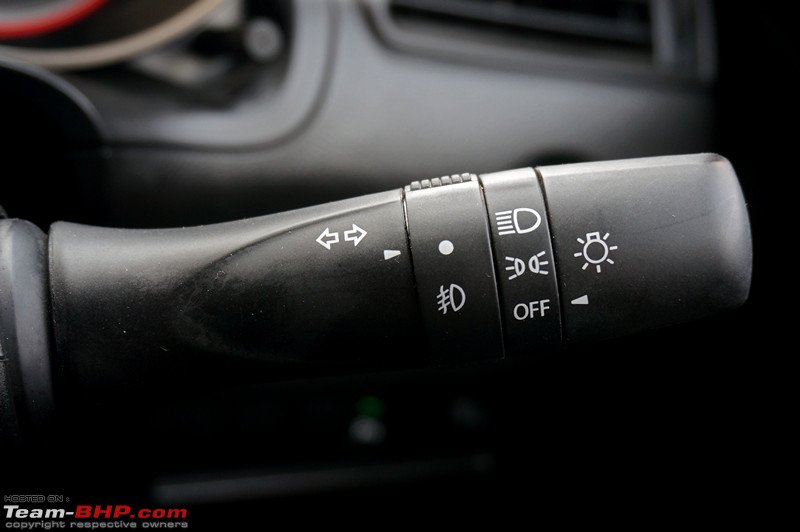 While the steering wheel of the Z+ variant gets a button for voice commands, lower variants get a Bluetooth button. Pressing it takes the ICE to the Bluetooth setup menu for smartphone pairing: 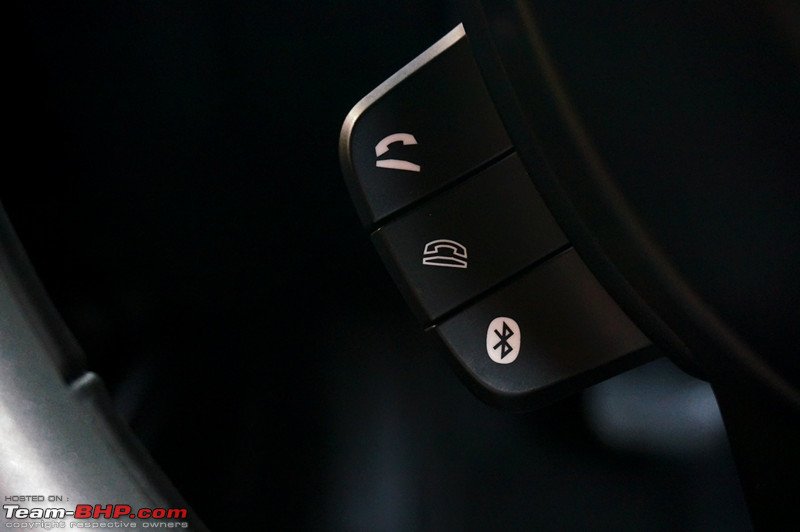 Spiral cord with the wire for the seatbelt sensor is visible, but covered: 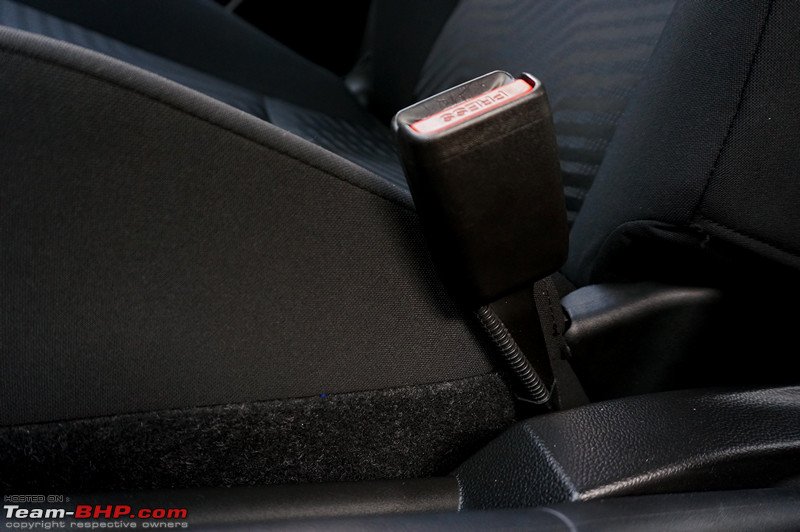 Hooks to lock the floor mat in place only on the driver's side (some cars have it on the passenger side too): 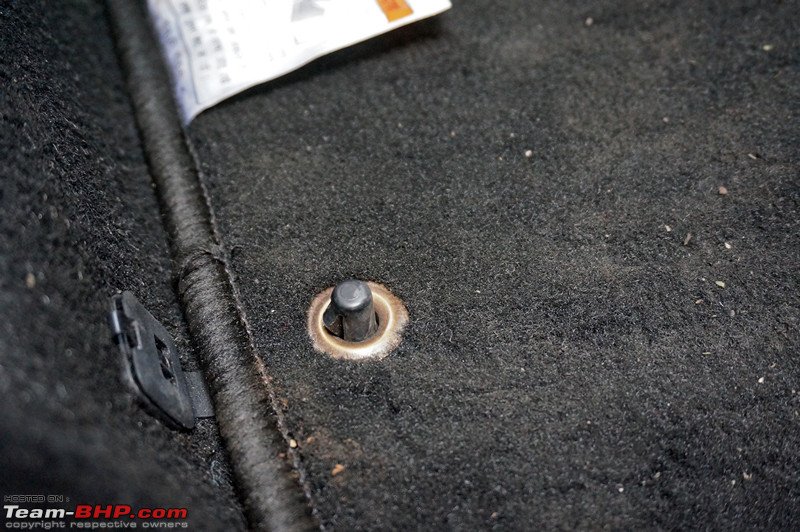 Warning label in English as well as Hindi! 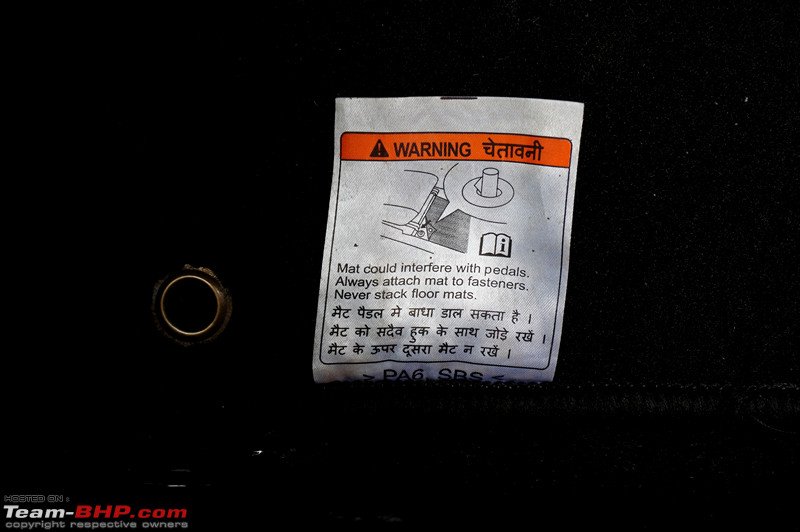 Basic 'door ajar' warning light doesn't specify which door is open. No display on the MID either: 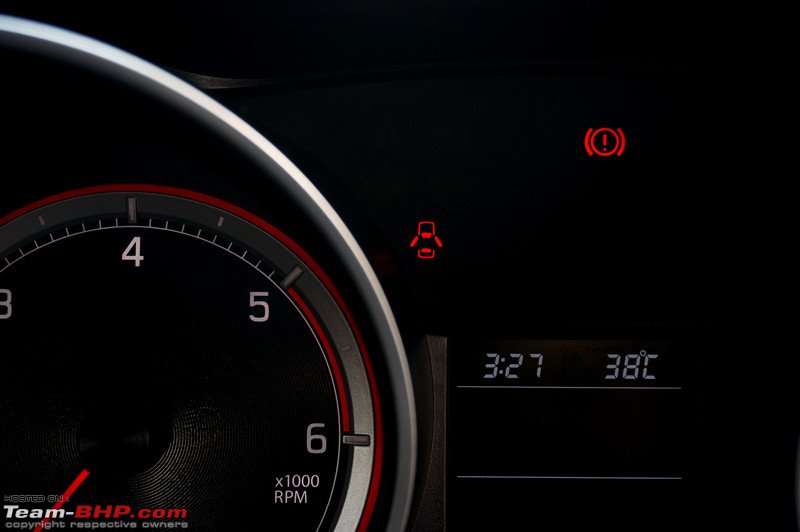 To enter 'accessory mode', press the engine start button without the clutch (brake in the AMT). This is denoted by a light on the instrument cluster:  In other markets, the Swift gets engine start/stop and cruise control. However, the dials used are the same. Indicator for the engine start/stop feature is located in the tachometer... 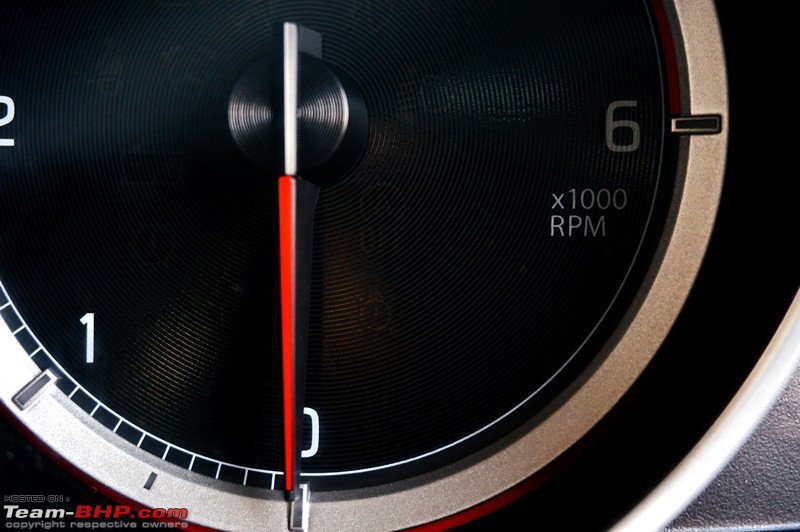 ...while the indicator for cruise control is housed in the speedometer: 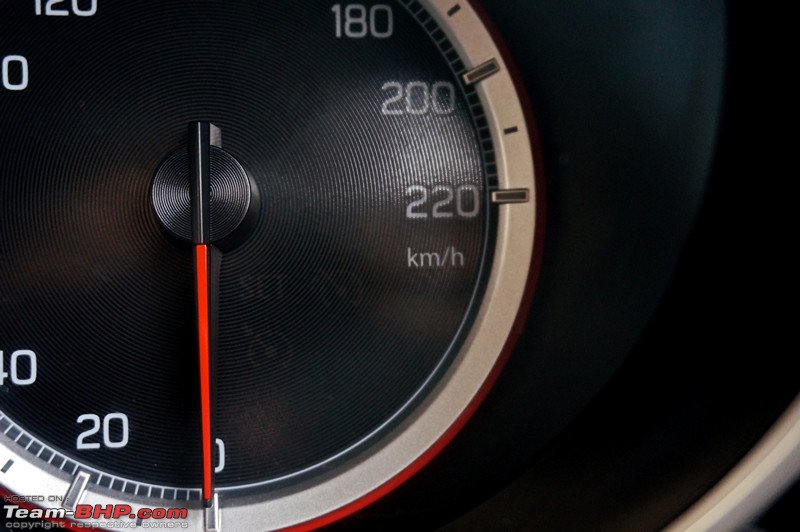 Keyfob is identical to the Dzire's in design. However, the boot release button is missing: 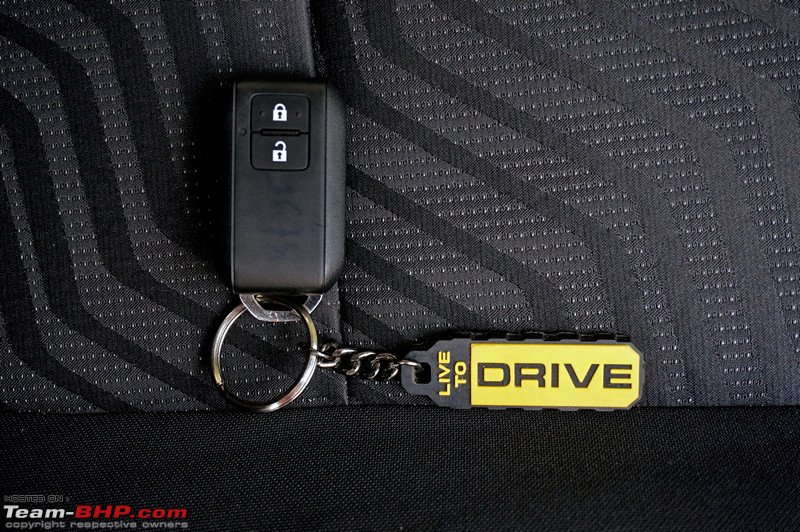 OBD port is located below the dashboard (in the driver's footwell): 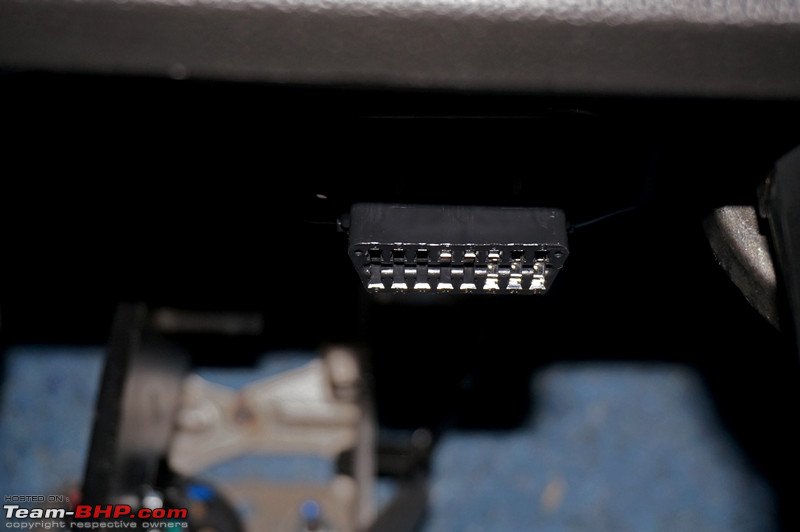 Red light keeps blinking whenever the car is locked, indicating that the security system is armed: 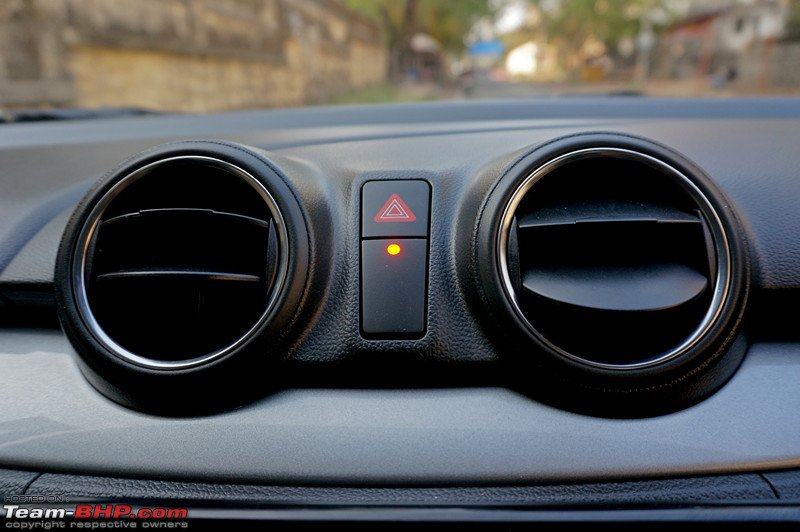 Horn discs are located right in the front. The tone is neutral-sounding, but not as sweet as the wind-tone units of European cars: 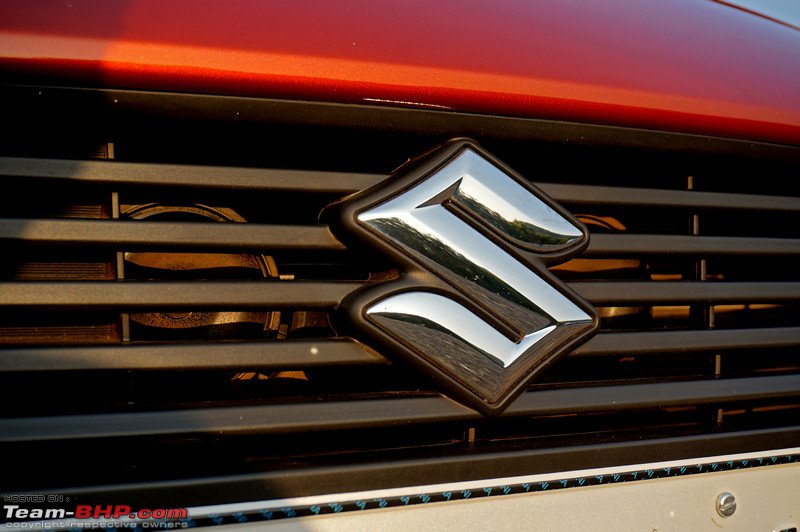 Subtle protrusion on the cladding of the rear wheel arch acts as a splash guard: 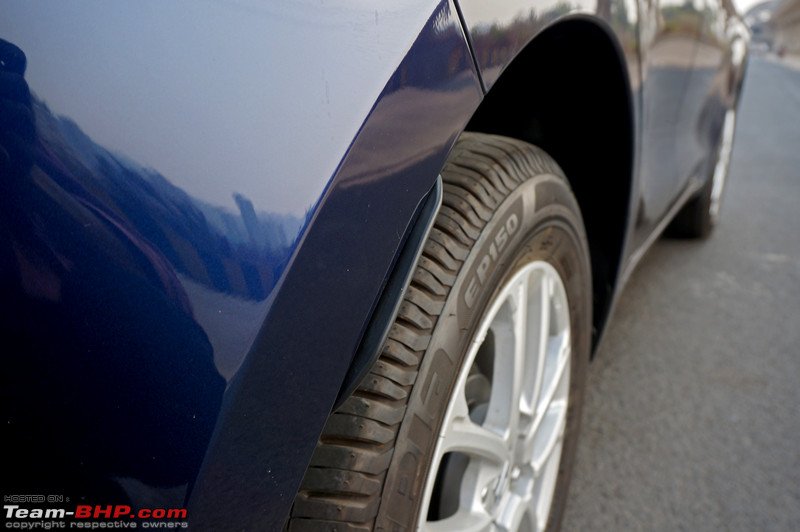 |
| |  (61)
Thanks (61)
Thanks
 |
| The following 61 BHPians Thank Aditya for this useful post: | 2himanshu, Abhi_abarth, ACFT, Added_flavor, AltoLXI, audioholic, AYP, bhavik.1991, CarguyNish, carrazy, chiranjitp, CornerCarver, dailydriver, Dr.Naren, DrANTO, espraveen, Flyer, Gannu_1, GTO, HappyRoadie, hdman, Hrishi_111, InControl, jayram.r, Keynote, knightrider_7, Leoshashi, libranof1987, Meer, mh09ad5578, mohansrides, N33raj, Nimalan, Nonstop-driver, Omkar, phoenixash, PraNeel, PrideRed, Rambo-RS, Researcher, revintup, romeomidhun, RoverX, S.MJet, sandx, Santoshbhat, Sheel, shreyak_ss, Simhi, sri2012, sukiwa, The Rationalist, theexperthand, uday.ere, vb-saan, VeluM, vibbs, Vik0728, vredesbyrd, vsrivatsa, WAM-4 |
| |
| | #12 |
| Team-BHP Support  | Re: Maruti Swift : Official Review Thread moved from the Assembly Line to Official Reviews. Thanks for sharing, Aditya! Fantastic review as always - rating thread 5 stars. The Petrol MT hits the bull's eye - it's the top choice for young folk & small families. Very fun to drive (I truly enjoyed high-revving it at night) and a more sorted car than its predecessor. Ordinary part quality aside, even the interiors wow you at night, especially those red dials & the flat-bottom steering wheel. But I wouldn't pick the diesel because of the old 1.3L motor. The engine is on top of my priority list whenever I'm shopping for a car. Hence, give me the i20, Figo or Polo diesels over this any day. Even the Diesel AMT is so damn jerky - I'd never even consider it. How spoilt for choice we are today. For every engine + transmission combination, my pick would be a different car. The Swift's mass appeal is evidenced by the fact that it attracted the most neighbours when parked down my house - right from young dudes to housewives, and college students to senior citizens. And the Swift was a frequent visitor because we insisted on test-driving all 4 engine + gearbox combinations in Bombay! Last edited by GTO : 19th April 2018 at 12:16. |
| |  (51)
Thanks (51)
Thanks
 |
| The following 51 BHPians Thank GTO for this useful post: | Abhi_abarth, Added_flavor, Aditya, AltoLXI, am1m, anthusiast, Ashir, bhavik.1991, chiranjitp, CornerCarver, dailydriver, deetjohn, Dennis, Dr.Naren, DrANTO, dsnaveen21, espraveen, Flyer, Gannu_1, InControl, Keynote, Leoshashi, libranof1987, mohansrides, nmenon, PrideRed, Rajeevraj, Rambo-RS, Researcher, RJ2285, romeomidhun, RoverX, roy_libran, S.MJet, sandx, Sheel, shreyak_ss, Sip, sri_tesla, sudipt123, sumeethaldankar, swiftdiesel, swiftnfurious, The Rationalist, theexperthand, uday.ere, vb-saan, VeluM, Vik0728, vipinendran, WAM-4 |
| | #13 |
| Senior - BHPian Join Date: Nov 2007 Location: IN
Posts: 3,329
Thanked: 5,117 Times
| Re: Maruti Swift : Official Review Can a car review be more exhaustive or comprehensive than this? No chance! Excellent effort, excellent output! Swift is a brand as big as Maruti. While the efforts to satisfy the fans are good, Maruti has to make the car real premium by offering super quality materials and 5-star safety. They are already charging a premium for that, and people are ready to pay. |
| |  (2)
Thanks (2)
Thanks
 |
| The following 2 BHPians Thank romeomidhun for this useful post: | S.MJet, VeluM |
| | #14 | |
| Senior - BHPian Join Date: May 2012 Location: BLR/PTR
Posts: 3,370
Thanked: 10,182 Times
| Re: Maruti Swift : Official Review Quote:
| |
| |  ()
Thanks ()
Thanks
 |
| | #15 | |
| Distinguished - BHPian  | Re: Maruti Swift : Official Review Excellent and detailed review. Rating 5 stars! Quote:
 Look at the way this engine revvs!!(My Baleno) Last edited by Dr.Naren : 19th April 2018 at 13:44. | |
| |  (12)
Thanks (12)
Thanks
 |
| The following 12 BHPians Thank Dr.Naren for this useful post: | chiranjitp, diliprayar, DrANTO, InControl, Leoshashi, rakesh_r, romeomidhun, RoverX, S.MJet, Sip, theexperthand, Vikram9193 |
 |



